NUCLEAR ENERGY IN A LOW-CARBON FUTURE: Implications for the United States and Japan
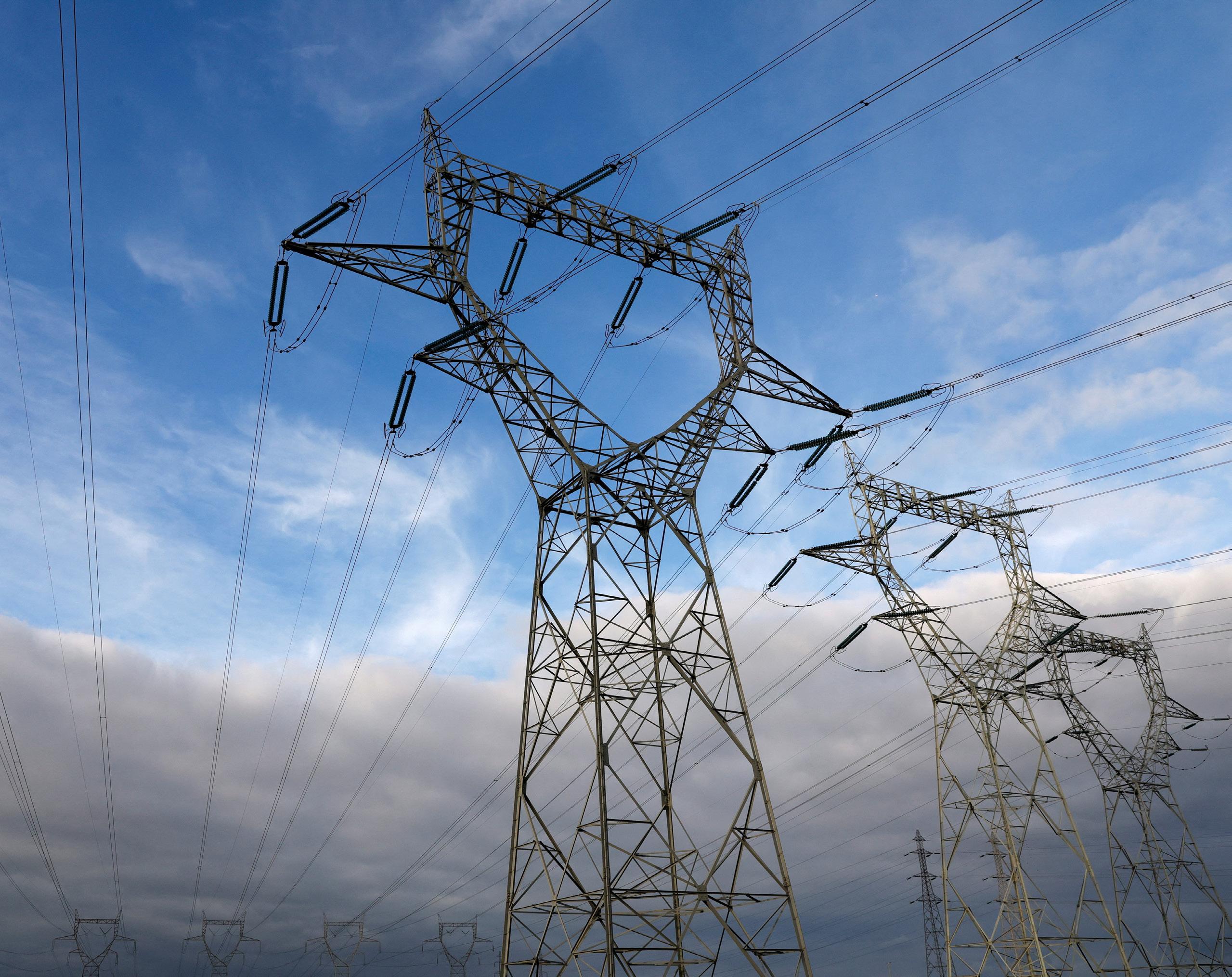 WRITTEN BY Stephen S. Greene
WRITTEN BY Stephen S. Greene
Atlantic Council GLOBAL
ENERGY CENTER
The Global Energy Center promotes energy security by working alongside government, industry, civil society, and public stakeholders to devise pragmatic solutions to the geopolitical, sustainability, and economic challenges of the changing global energy landscape.
This report is written and published in accordance with the Atlantic Council Policy on Intellectual Independence. The authors are solely responsible for its analysis and recommendations. The Atlantic Council and its donors do not determine, nor do they necessarily endorse or advocate for, any of this report’s conclusions.
Atlantic Council 1030 15th Street NW, 12th Floor Washington, DC 20005
For more information, please visit www.AtlanticCouncil.org.
The Atlantic Council is grateful to ClearPath Inc., the Howard Baker Forum, the Federation of Electric Power Companies of Japan, Tokyo Electric Power Company Holdings, and the Nuclear Energy Institute for their generous support of this project.
ISBN-13: 978-1-61977-257-1 November 2022
Design: Donald Partyka and Anais Gonzalez
Cover: Electrical power pylons of high-tension electricity power lines in Saint-Folquin, France, in October 2022. REUTERS/Pascal Rossignol

NUCLEAR ENERGY IN A LOW-CARBON FUTURE: Implications for the United States and Japan
Written by Stephen S. GreeneTable of Contents
Table of Contents 1
Introduction 3
I. Nuclear Energy and Decarbonization 4
II. Challenges to Decarbonization 9
III. Implications for the United States 14 IV. Implications for Japan 18
Conclusion 25
About the Author 27
Introduction
Nuclear energy has recently received renewed interest as a tool to address the dual challenges of energy security and climate change.1 At the United Nations Climate Change Conference (COP26), the US delegation highlighted the potential role of advanced nuclear generation in the climate strategy it presented at the conference.2 French President Emmanuel Macron has proposed a renewed emphasis on nuclear power, in addition to expanded renewable generation, to achieve France’s decarbonization goals. 3 China contin ues to rely on an extensive expansion of nuclear genera tion, as well as renewables, as it pursues decarbonization while addressing growing energy demand. 4 In the context of the energy market volatility resulting mainly from the war in Ukraine, Japan and other countries have renewed their pursuit of nuclear energy to improve energy security and achieve their decarbonization objectives.5
Nuclear power is a demonstrated source of dispatchable zero-carbon electricity. Today, it is the only zero-carbon, dispatchable option able to be deployed at scale (with the exception, in some regions, of hydropower and geothermal energy, which have geographic, resource, and environmen tal limitations). In addition, nuclear energy could be a fea sible source of power for hydrogen production that is not limited by renewable-resource availability, and advanced nuclear technology can produce heat at the high tempera tures required for many industrial processes.
Skeptics may contend that the long licensing and con struction time for conventional nuclear plants makes them incompatible with the objective of swift decarbonization of power systems. However, while the near-term acceleration of decarbonization may be achieved, in large part, through
1 https://www.iea.org/reports/nuclear-power-and-secure-energy-transitions.
rapid deployment of renewable energy, the challenging later stages will need dispatchable generation and stor age (including approaches to long-term storage that are still being developed).6 For example, with the addition of more variable renewable energy, weather will begin to have an effect on power supply as well as demand, and dispatchable generation—such as nuclear power—will be needed to help support reliability.
In the International Energy Agency’s net-zero scenario, worldwide electric demand will almost double between 2030 and 2050, and, in that period, more than five thousand giga watts (GW) of new dispatchable generation and storage will need to be added.7 By that time, advanced nuclear technol ogies that are currently being built and demonstrated will be in operation, and those technologies will be available for broader deployment, in addition to conventional nuclear power options.
Nuclear energy has the potential to be a key component of decarbonization strategies worldwide. This paper dis cusses the value nuclear energy can have in a decarboniza tion framework, the challenges decarbonization efforts may face, how nuclear energy could contribute to decarboniza tion efforts in the United States and Japan, and steps that could strengthen those efforts.
2 Robinson Meyer, “Nuclear Is Hot, for the Moment,” Atlantic, November 10, 2021, https://www.theatlantic.com/science/archive/2021/11/nuclear-power-hotmoment/620665.
3 Liz Alderman, “France Announces Major Nuclear Power Buildup,” New York Times, February 10, 2022, https://www.nytimes.com/2022/02/10/world/europe/francemacron-nuclear-power.html.
4 Dan Murtaugh and Krystal Chia, “China’s Climate Goals Hinge on a $440 Billion Nuclear Buildout,” Bloomberg, November 2, 2021, https://www.bloomberg.com/news/ features/2021-11-02/china-climate-goals-hinge-on-440-billion-nuclear-power-plan-to-rival-u-s.
5 “EU Taxonomy: Commission Begins Expert Consultations on Complementary Delegated Act Covering Certain Nuclear and Gas Activities,” European Commission, January 1, 2022, https://ec.europa.eu/commission/presscorner/detail/en/ip_22_2.
6 See, e.g., Nestor A. Sepulveda, et al., “The Role of Firm Low-Carbon Electricity Resources in Deep Decarbonization of Power Generation,” Joule (2018): 2403–2420 accessed May 6, 2022, https://doi.org/10.1016/j.joule.2018.08.006.
7 “Net Zero by 2050 Scenario—Data Product,” International Energy Agency, May 2021, https://www.iea.org/data-and-statistics/data-product/net-zero-by-2050-scenario.
I. Nuclear Energy and Decarbonization
Nuclear energy has among the lowest levels of life cycle carbon-dioxide (CO2) emissions of all pow er-generation options, according to some stud ies, lower than wind or solar energy.8 Nuclear energy is both time independent (it is dispatchable, and its availability does not vary with weather conditions) and loca tion independent (it does not depend on natural availability of renewable resources like hydropower, wind, solar, or geo thermal energy).9 It, therefore, provides a route to zero-car bon energy for regions where renewable resources are less available, and provides power that is not subject to weather variability, reducing the need for energy storage and its associated costs. It provides another option for zero-carbon energy that is less land intensive than renewables, and that imposes less of an impact on the physical space (e.g., less of a visibility impact), representing an alternative approach that may be more attractive to some communities.
Today, nuclear power is a major source of zero-carbon energy. It is the largest source of zero-carbon electricity in “advanced economies,” as defined by the International Energy Agency (IEA), representing 40 percent of zero-car bon power and exceeding the output of renewable genera tion, despite recent efforts to accelerate deployment of wind and solar power.10 Nuclear energy is also a cornerstone of the US power sector, representing 20 percent of electric gener ation (including about half of zero-carbon electricity) and 25 percent in the European Union (about 40 percent of zero-car bon electricity).
There is now extensive development of advanced nuclear designs that take new approaches to nuclear energy. These advanced designs make construction more efficient, inte grate more readily into power systems that include variable renewable generation, make safety and security part of the
inherent design (which also decreases costs and increases siting options), and, in many cases, can support industrial power needs and efficient hydrogen production, in addition to electric generation.11 The attributes of advanced nuclear reactors include the following.
• Efficient construction: advanced designs can be modular, with an emphasis on components that can be manufac tured in a factory, and which, therefore, require less onsite construction and result in shorter construction times. Long construction times are a key contributor to high costs, with the cost of construction financing representing a significant portion of traditional nuclear power costs. Modular design also allows more rapid iteration, resulting in improved cost and efficiency through technological learning.
• Better integration: modular designs allow generation capacity to be added in smaller increments, better match ing growth needs and imposing less financial stress on project sponsors. Advanced designs also incorporate greater ability to change power output levels than tradi tional designs (especially those historically used in the United States); some emphasize fast ramping speeds to rapidly respond to changing levels of renewable power, and some incorporate thermal energy storage, which may be more cost effective than battery storage.
• Inherent safety and security: advanced approaches incor porate safety features as an inherent element of the designs, typically relying on “passive” features, such as gravity or natural heat convection, to cool reactors without requiring mechanical intervention. In addition to making safety systems even more reliable, this approach reduces the amount of equipment required to ensure safety, which decreases overall costs.
8 Hannah Ritchie, “What Are the Safest and Cleanest Sources of Energy?” Our World in Data, February 10, 2020, https://ourworldindata.org/safest-sources-of-energy.
9 Conventional nuclear power plants require water for cooling, though there are options to reduce the impact on water resources, and many advanced nuclear technologies use alternative approaches that avoid significant water use.
10 “Nuclear Power in a Clean Energy System,” International Energy Agency, May 2019, https://www.iea.org/reports/nuclear-power-in-a-clean-energy-system.
11 There are several references for more complete technical discussions of advanced nuclear technology, such as International Atomic Energy Agency, Division of Nuclear Power, Nuclear Power Technology Development Section, Vienna (Austria) (2020); “Advances in Small Modular Reactor Technology Developments A Supplement to: IAEA Advanced Reactors Information System (ARIS) 2020 Edition,” International Atomic Energy Agency, September 2020, https://inis.iaea.org/search/ search.aspx?orig_q=RN:51111609; “Advanced Nuclear Reactor Technology: A Primer,” Nuclear Innovation Alliance, 2021, https://www.nuclearinnovationalliance.org/ advanced-nuclear-reactor-technology-primer.
Figure 1: Nuclear Energy and Sustainable Development
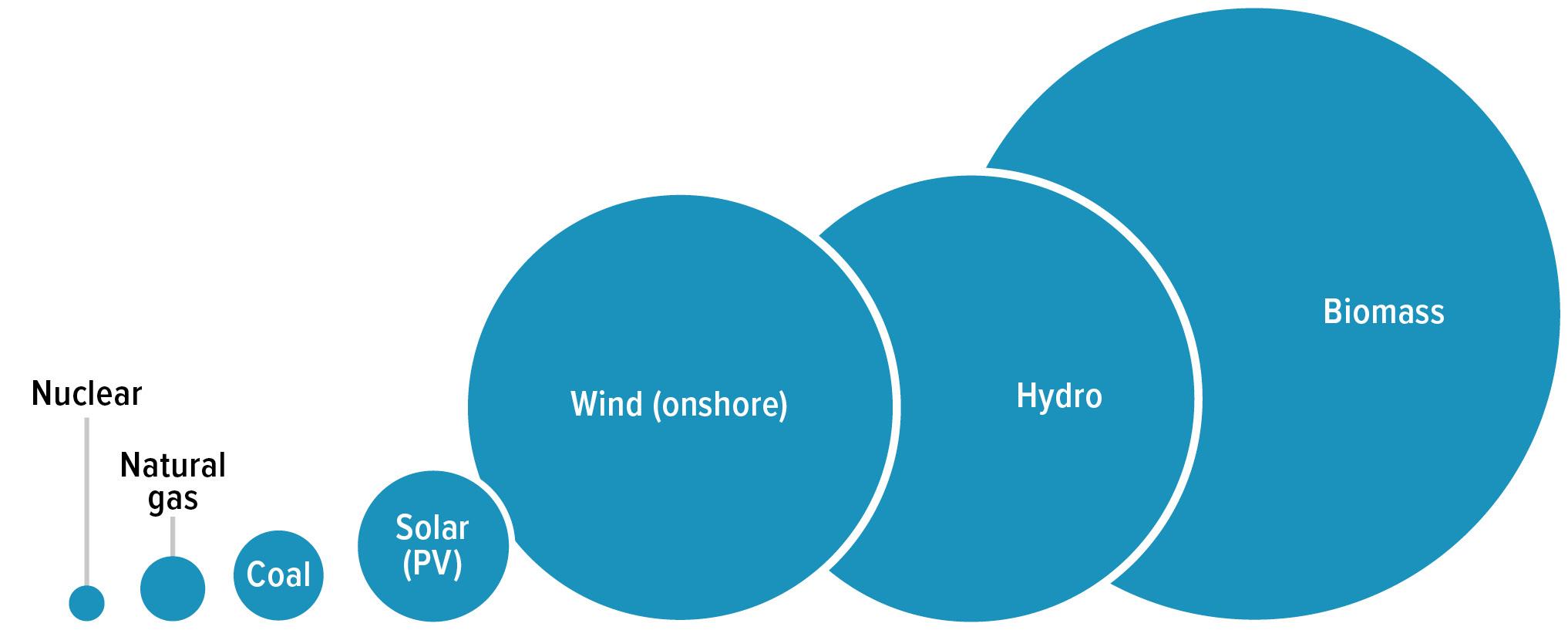
SOURCE: “NUCLEAR ENERGY AND SUSTAINABLE DEVELOPMENT,” WORLD NUCLEAR ASSOCIATION, UPDATED APRIL 2020, HTTPS://WORLD-NUCLEAR.ORG/INFORMATION-LIBRARY/ENERGY-AND-THE-ENVIRONMENT/NUCLEAR-ENERGY-AND-SUSTAINABLE-DEVELOPMENT.ASPX.
• Industrial integration: many designs incorporate high-tem perature output compatible with many industrial require ments (discussed further below), which also improve the ability of the reactor to produce hydrogen.
The two demonstrations funded under the US Advanced Reactor Demonstration Program (ARDP) involve designs incorporating many of these features. The Natrium design to be constructed in Wyoming allows the reactor to oper ate at a steady output equivalent to three hundred and for ty-five megawatts (MW), but incorporates a thermal storage system so that it can deliver as little as one hundred mega watts while renewable energy is available, but up to five hun dred megawatts for 5.5 hours when renewable energy pro duction decreases, such as in the evening in a system with substantial solar power.12 The X-energy Xe-100 reactor to be constructed in the state of Washington is built in 80-MW mod
ules, operates at high temperatures with a helium coolant, and incorporates continuous refueling with tri-structural iso tropic (TRISO) particle fuel that can withstand high tempera tures and does not melt.13
Deployment Flexibility
Nuclear energy, by its nature, produces a substantial amount of energy in a small land area, especially compared to renew able power. A two-unit nuclear power plant able to provide electricity for four to five million people covers a footprint of just two square kilometers.14 For an equal amount of lifetime energy, solar photovoltaic generation may require about sixty times as much land as nuclear generation, and wind gener ation may cover almost five hundred times as much land, though the space between the turbines can be put to other uses (See Figure 1).15
12 “Advanced Nuclear Reactor Technology.”
13 Ibid.; “X-Energy,” X-Energy, last visited May 6, 2022, https://x-energy.com/.
14 “Nuclear Energy and Sustainable Development,” World Nuclear Association, last updated April 2020, https://world-nuclear.org/information-library/energy-and-theenvironment/nuclear-energy-and-sustainable-development.aspx.
15 Estimates of land use for power generation vary widely. These estimates are from Barry W. Brook and Corey J. A. Bradshaw, “Key Role for Nuclear Energy in Global Biodiversity Conservation,” Conservation Biology (2015): 702–712, https://conbio.onlinelibrary.wiley.com/doi/epdf/10.1111/cobi.12433.
The modular design, moderate size, and inherent safety fea tures of advanced nuclear approaches enable flexibility in deploying new generation. The Natrium demonstration proj ect, for example, will demonstrate the feasibility of siting new nuclear generation at the site of a retired coal plant. Doing so will enable using a brownfield site rather than develop ing new land for power generation, will take advantage of existing electrical infrastructure, such as the substation and transmission, and will benefit the community through provid ing jobs to replace those lost to the coal plant retirement and through adding to the tax base. Four communities sought to be considered for the demonstration and the project ulti mately selected a site in Kemmerer, Wyoming.16
Resilience
Nuclear power plants are capable of dispatchable opera tion to operate in systems alongside renewable generation. As noted earlier, advanced nuclear designs are capable of extended power flexibility (ramping), and some incorporate efficient thermal storage. They are also capable of contin ued, reliable generation that is not subject to weather con ditions, such as those that can threaten systems that rely on high concentrations of renewable power.
Furthermore, nuclear generation is highly resilient under extreme weather conditions. Nuclear refueling cycles are more than a year long, so they are relatively insulated against fuel supply challenges such as those faced by natural-gas dependent regions today, or those that affected Asian lique fied natural gas (LNG) users and US natural gas generation during extended winter conditions in early 2021, and even against extended supply shortages. If properly weatherized, nuclear generators can operate reliably in the harshest con ditions. For example, although one nuclear unit incurred an outage due to cold weather impacts on its feedwater system (which were avoidable with proper winterization) during the Texas winter storm in early 2021, it was restored to full power within three days.17 Nuclear plants had the best performance of any generation technology during that event, delivering 79 percent of their expected performance, compared to nat ural gas generators at 55 percent and wind at 57 percent.18
Industrial Energy
One of the more challenging areas of energy use to decar bonize is industrial process heat. Worldwide, about 75 per cent of industrial heat is generated with fossil fuels.19 Many advanced nuclear technologies, including those in the ARDP, are able to generate temperatures higher than conventional reactors because of their innovative fuels and coolants. These reactors can produce heat in the range of 600–800 degrees Celsius, which is suitable for many industrial require ments, such as pulp and paper manufacturing, methanol pro duction, and ammonia synthesis.20 Japan’s High Temperature Engineering Test Reactor (HTTR) can produce heat at nine hundred and fifty degrees Celsius, potentially opening the door to further industrial applications.21
Hydrogen
Obtaining even higher temperatures, such as those required for steel production with blast furnaces, cement, and glass production, may require the use of alternative fuels that can be combusted without producing CO2. Hydrogen has attracted great interest as a potential fuel, or as a key pre cursor to alternative fuels, such as ammonia. Hydrogen or alternative fuels made with hydrogen may also be critical to support carbon-free freight transport, such as heavy trucking and marine transport, for which battery power may be inad equate or impractical.
Much of the discussion about producing hydrogen has focused on production through electrolysis using renewable electricity (so-called “green” hydrogen) or adding carbon capture to the current carbon-intensive production through methane (natural gas) reforming (with carbon capture, this is so-called “blue” hydrogen). Hydrogen can also be produced through electrolysis using nuclear electricity, and doing so could have some advantages (some discussions characterize nuclear-produced hydrogen as “pink,” but the color scheme is faulty; because nuclear electricity is carbon free, there is no reason to designate it differently than hydrogen produced by renewables).
16 Dan Yurman, “TerraPower Selects Kemmerer WY for Natrium Reactor,” Neutron Bytes, November 18, 2021, https://neutronbytes.com/2021/11/18/terrapower-selectskemmerer-wy-for-natrium-reactor.
17 Michael McAuliffe, “Texas Nuclear Unit Returns to Service after Outage Related to Cold Weather,” S&P Global, February 18, 2021, https://www.spglobal.com/platts/en/ market-insights/latest-news/electric-power/021821-texas-nuclear-unit-returns-to-service-after-outage-related-to-cold-weather.
18 Derek Stenclik, et al., “Redefining Resource Adequacy for Modern Power Systems,” Energy Systems Integration Group, 2021, https://www.esig.energy/resourceadequacy-for-modern-power-systems/.
19 Nathaniel Bullard, “Taking the Gas (and Coal) Out of Heat,” Bloomberg, September 16, 2021, https://www.bloomberg.com/news/articles/2021-09-16/making-things-hottranslates-to-substantial-greenhouse-gas-emissions.
20 Julio Friedmann, Zhiyuan Fan, and Ke Tang, “Low-Carbon Heat Solutions for Heavy Industry: Sources, Options, and Costs Today,” Columbia University School of International and Public Affairs, Center on Global Energy Policy, October 7, 2019, https://www.energypolicy.columbia.edu/research/report/low-carbon-heat-solutionsheavy-industry-sources-options-and-costs-today.
21 https://www.nice-future.org/assets/pdfs/japan.pdf.
The key factors in hydrogen production through electrolysis are the cost of the electricity, the capacity factor (percent of output) of the available power, and the capital cost and effi ciency of the electrolyzer. The standalone cost of power from a new solar or wind project (without considering system costs that may be necessary to integrate these projects) is less than that from a new nuclear power plant, though advanced nuclear plants may be able to decrease their costs when they have had more time to mature, as renewable technolo gies have.22 However, the capacity factor for nuclear power plants is much greater than that for renewable power; in the United States in 2019, the average capacity factor for nuclear power was 94 percent vs. 35 percent for wind and 25 per cent for solar.23 The higher capacity of nuclear power results in better utilization of the electrolyzer, and so can partially offset a higher average per unit cost of power. Furthermore, nuclear power, which produces heat, can be used to sup port high-temperature electrolysis that uses 24 percent less energy than the approach that can be used with renew ables.24 Using its HTTR, the Japan Atomic Energy Agency (JAEA) is testing a thermochemical method of hydrogen pro duction that could result in even greater efficiency. 25
Considering these factors could make hydrogen production with nuclear energy attractive compared with production using renewables. The US Department of Energy, through the Idaho National Laboratory, has conducted several assessments of hydrogen production with nuclear energy. Some conclude that such approaches could deliver hydro gen for $1–2 per kilogram of hydrogen, in the target range for the hydrogen “Earthshot” program.”26 The Department of Energy is currently sponsoring several demonstrations of hydrogen production at existing nuclear plants.27 Most of these demonstrations will incorporate low-temperature elec trolysis, due to the technical constraints of demonstrations at existing facilities; however, one demonstration in Minnesota will test high-temperature electrolysis.28
In addition to better capacity factors and better efficiency, production of hydrogen with nuclear energy could be located closer to demand centers, thereby mitigating the complica tions of storing and transporting hydrogen, especially in the early stages of a developing hydrogen infrastructure. 29 Nuclear power plants in industrial hubs could supply both process heat and hydrogen. Hydrogen could be produced with nuclear power at shipping hubs to support marine trans port. 30 Hydrogen produced with nuclear power would be particularly suitable for Japan, because renewable gener ation options are limited, natural gas is not readily available in Japan for hydrogen production using methane reforming, and seaborne hydrogen transport is difficult and inefficient.
Worldwide Interest in Nuclear Power
In the context of climate change and a desire to achieve inde pendence from reliance on fossil fuels, interest in nuclear energy has grown worldwide, beyond the efforts in the United States. Ontario, Canada, already relies on nuclear power for 60 percent of its electric generation.31 In December 2019, it signed a memorandum of understanding (MOU) with the provinces of New Brunswick and Saskatchewan to collaborate on advancing development and deploy ment of a small modular reactor (SMR). The MOU contem plates three streams of deployment: initial deployment of a three-hundred-megawatt reactor in Ontario (Darlington site) by 2028, with subsequent deployments in Saskatchewan; deployment of advanced reactors in New Brunswick (Point Lepreau); and demonstration of a microreactor in Ontario.32 Engineering and design work for the Darlington SMR was pursued with three developers, and, in December 2021, Ontario Power chose to proceed with GE-Hitachi’s BWRX300 reactor.33 The Ontario microreactor, Global First Power’s fifteen-megawatt thermal demonstration of the Ultra Safe
22 “Levelized Cost Of Energy, Levelized Cost Of Storage, and Levelized Cost Of Hydrogen 2020,” Lazard, October 19, 2020, https://www.lazard.com/perspective/lcoe2020.
23 “Infographic—Capacity Factor by Energy Source—2019,” US Department of Energy, Office of Nuclear Energy, May 19, 2020, https://www.energy.gov/ne/downloads/infographic-capacity-factor-energy-source-2019.
24 Mark F. Ruth, et al., “The Technical and Economic Potential of the H2@Scale Concept within the United States,” National Renewable Energy Laboratory, October 2020, https://www.nrel.gov/docs/fy21osti/77610.pdf.
25 Matt Fisher, “Nuclear Energy for Non-Electric Applications Key for Climate Change Mitigation,” International Atomic Energy Agency, Department of Nuclear Energy, August 7, 2020, https://www.iaea.org/newscenter/news/nuclear-energy-for-non-electric-applications-key-for-climate-change-mitigation.
26 See, e.g., Richard D. Boardman, “Evaluation of Non-electric Market Options for a Light-water Reactor in the Midwest. Light Water Reactor Sustainability Program,” US Department of Energy, Office of Scientific and Technical Information, August 1, 2019, https://www.osti.gov/biblio/1559965-evaluation-non-electric-market-options-lightwater-reactor-midwest; “Secretary Granholm Launches Hydrogen Energy Earthshot to Accelerate Breakthroughs Toward a Net-Zero Economy,” US Department of Energy, press release, June 7, 2021, https://www.energy.gov/articles/secretary-granholm-launches-hydrogen-energy-earthshot-accelerate-breakthroughs-toward-net.
27 David Kramer, “Could Hydrogen Bail out Nuclear Power?” Physics Today (2020): 20–21, https://physicstoday.scitation.org/doi/10.1063/PT.3.4543.
28 “Xcel Energy’s Prairie Island Likely Hydrogen Demo Site,” Nuclear News, November 11, 2020, https://www.ans.org/news/article-2366/xcel-energys-prairie-island-likely-hydrogen-demo-site/.
29 See, e.g., Cynthia Quarterman, Brief 3: Hydrogen Transportation and Storage, Atlantic Council, July 21, 2019, https://www.atlanticcouncil.org/content-series/hydrogen-policy-sprint/hydrogen-policy-sprint-brief-3/.
30 Mike Fowler, et al., “Bridging the Gap: How Nuclear-Derived Zero-Carbon Fuels Can Help Decarbonize Marine Shipping,” Clean Air Task Force, August 4, 2021, https://www.catf.us/resource/nuclear-zero-carbon-fuels-shipping/.
31 “2021 Year in Review,” Independent Electricity System Operator, 2021, https://www.ieso.ca/corporate-ieso/media/year-end-data.
32 “Ontario,” Canada’s SMR Action Plan, December 18, 2020, https://smractionplan.ca/content/ontario.
33 Matthew McClearn and Laura Stone, “Ontario Power Generation Announces Who Will Design New Modular Reactor,” Globe and Mail, December 1, 2021, https://www.theglobeandmail.com/canada/article-ontario-power-generation-announces-who-will-design-new-modular-reactor.
Nuclear Corporation’s high-temperature gas microreactor, is expected to be deployed in 2025.34
Parts of Europe already rely on nuclear power for a substan tial part of their electric generation. Fourteen of the twen ty-eight EU member states generate electricity with nuclear power, which provides 27 percent of European electric gen eration and 50 percent of its low-carbon electricity.35 The UK has committed to nuclear power as part of its net-zero strat egy. As noted earlier, France has committed to relaunch con struction of nuclear reactors.36 In the Netherlands, the gov ernment commissioned an assessment of nuclear power as part of its review of options for the energy transition. This assessment found that the system costs for nuclear power are lower than those for variable renewables, and, after adjusting for those system costs, the effective levelized cost for nuclear could be lower than that for wind or solar.37 The Netherlands could consider additional nuclear power after 2030, particularly small modular reactors.38 In Central and Eastern Europe, the government of Poland has strong interest in nuclear power as a means of transitioning out of the coun try’s heavy reliance on coal, and signed an agreement with the US government to collaborate on a civil nuclear program, which led to a letter of intent from the US Export-Import Bank to support the project.39 Romania, Bulgaria, and Ukraine have also expressed interest in working with the United States on nuclear power.40 And, in November 2021 (during COP26), Romanian nuclear energy producer Nuclearelectrica agreed to deploy a NuScale SMR.41 In July, 2021, nearly one hundred Members of the European Parliament signed a letter calling on the European Commission to include nuclear power in the EU’s Sustainable Finance Taxonomy as an essential step in recognizing and supporting nuclear power’s role as a tool to address the climate crisis.42 In July 2022, the European
Parliament voted to include nuclear power in the Taxonomy as a sustainable transition resource, albeit with limitations. 43
Nuclear power can serve as an element of sustainable devel opment, not only in decarbonizing the energy sector, but also supporting the attainment of other sustainable-development goals.44 The World Nuclear Association identifies about thirty countries that are considering, planning, or starting nucle ar-power programs.45 The US think tank Third Way has char acterized global markets for advanced nuclear technology, and identified significant opportunities for new nuclear devel opment in new-to-nuclear countries, as well as countries cur rently operating nuclear power plants with growing energy demand and/or the need to replace coal-fired generation.46 However, the World Bank continues to reject funding for nuclear power.47
Advanced nuclear technologies may be of particular inter est in many new-to-nuclear countries, as those technologies are designed to add generation in smaller increments that may be more easily integrated into smaller or developing power systems. For that interest to materialize, it is essen tial that these technologies be initially deployed in countries where nuclear generation is already established, to provide the assurance of review by established regulatory processes, and some clarity on cost and construction feasibility.
34 Alan Ahn, et al., “Advanced Reactors: Turning the Corner,” Advanced Nuclear Energy, June 16, 2021, https://www.advancednuclearenergy.org/product/advanced-reactors-turning-the-corner.
35 “Nuclear Generates Almost Half of Europe’s Low-Carbon Electricity,” FORATOM, last visited May 6, 2022, https://www.foratom.org/facts-figures/.
36 Ingrid Melander, “Macron Says France Will Build New Nuclear Energy Reactors,” Reuters, November 9, 2021, https://www.reuters.com/business/energy/macron-says-france-will-build-more-nuclear-energy-reactors-2021-11-09.
37 “Possible Role of Nuclear in the Dutch Energy Mix in the Future,” Ministry of Economic Affairs and Climate Policy of the Netherlands, September 1, 2020, https://www.rijksoverheid.nl/ministeries/ministerie-van-economische-zaken-en-klimaat/documenten/rapporten/2020/09/22/possible-role-of-nuclear-in-the-dutchenergy-mix-in-the-future. This condition may also be the case in Japan. See: “Outline of Strategic Energy Plan,” Ministry of Economy, Trade, and Industry (Japan), October 2021, https://www.enecho.meti.go.jp/en/category/others/basic_plan/pdf/6th_outline.pdf.
38 “Netherlands Considers More Nuclear Power,” Nuclear Energy International, September 28, 2020, https://www.neimagazine.com/news/newsnetherlands-pushes-for-more-nuclear-8153490.
39 Cole Simons, “America: The Trusted Partner for Nuclear Exports,” ClearPath, November 19, 2020, https://clearpath.org/our-take/america-the-trusted-partner-for-nuclear-energy-exports.
40 Ibid.
41 “Romania’s Nuclearelectrica and the US NuScale Power Team Up to Bring First SMRs to Europe,” CEENERGYNEWS, November 15, 2021, https://ceenergynews.com/nuclear/romanias-nuclearelectrica-and-the-us-nuscale-power-team-up-to-bring-first-smrs-to-europe.
42 “MEPs Call on EC to Recognize Nuclear as Sustainable,” World Nuclear News, July 9, 2021, https://www.world-nuclear-news.org/Articles/MEPs-call-on-EC-to-recognise-nuclear-as-sustainabl.
43 https://www.reuters.com/business/sustainable-business/eu-parliament-vote-green-gas-nuclear-rules-2022-07-06/.
44 “The Role of Nuclear Energy in Sustainable Development,” United Nations Economic Commission for Europe, 2020, https://unece.org/fileadmin/DAM/energy/se/pdfs/egrm/egrm11_apr2020/EGRM-11_The_Role_of_Nuclear_Energy_in_Sustainable_Development__v11.pdf.
45 “Emerging Nuclear Energy Countries,” World Nuclear Association, January 2020, https://world-nuclear.org/information-library/country-profiles/others/emerging-nuclear-energy-countries.aspx.
46 Alan Ahn, et al., “2021 Update: Map of the Global Market for Advanced Nuclear,” Third Way, November 9, 2021, https://www.thirdway.org/memo/2021-update-map-of-the-global-market-for-advanced-nuclear.
47 Jonathan Tirone, “Nuclear Watchdog’s Pitch for World Bank Financing Makes Headway,” Bloomberg, October 25, 2021, https://www.bloomberg.com/news/articles/2021-10-25/nuclear-watchdog-s-pitch-for-world-bank-financing-makes-headway.
II. Challenges to Decarbonization
Worldwide strategies for decarbonization inevitably focus first on a substantial increase in the deployment of renewable energy. In Net Zero by 2050, the IEA anticipates that solar and wind power would constitute almost 70 percent of elec tric generation worldwide by 2050, and renewables over all (including hydropower) would represent almost 90 per cent (see Figure 2), with most of the remainder coming from nuclear.48 However, the availability of renewable resources varies significantly by region, and renewable energy may be a more robust resource for power generation in some coun tries than in others. Furthermore, renewable resources are location constrained, and it may be challenging, given the
structure of existing transmission systems and the difficulty expanding them, to move renewable power from the loca tions where it is generated to those where it will be used.
Renewable-energy generation is also time constrained. Especially in winter, when solar generation is severely con strained in mid-latitudes, unexpectedly calm conditions can lead to a disruptive shortfall of the remaining renewable (wind) generation.49 Without zero-carbon dispatchable gen eration, very large amounts of storage would be required to manage these shortfalls during infrequent, but inevitable, circumstances.
Figure 2: Global Electricity Generation by Source in IEA’s Net-Zero Emissions by 2050 Scenario
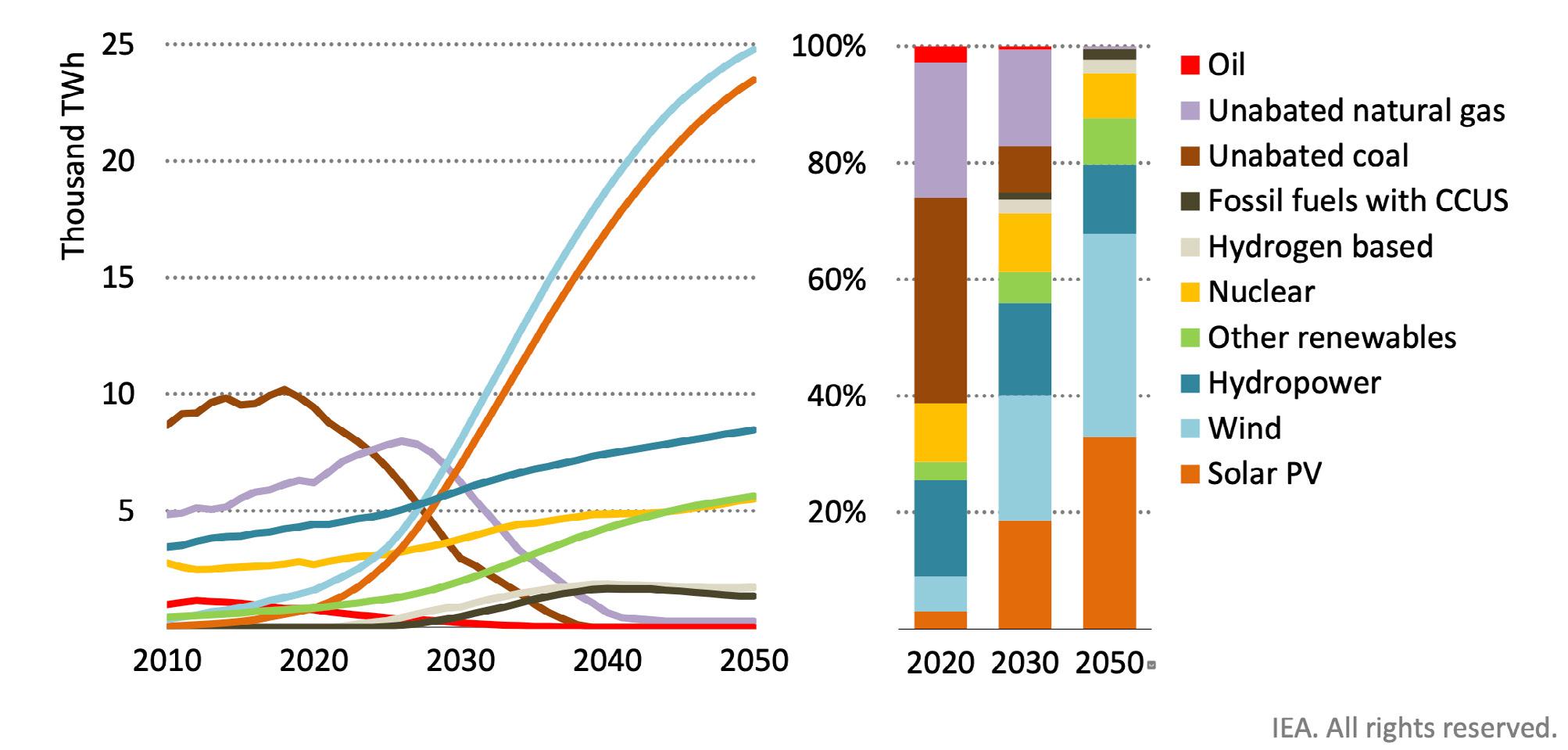
HTTPS://WWW.IEA.ORG/REPORTS/NET-ZERO-BY-2050.
48 “Net Zero by 2050,” International Energy Agency, May 2021, https://www.iea.org/reports/net-zero-by-2050.
49 Armond Cohen, et al., “Clean Firm Power Is the Key to California’s Carbon-Free Energy Future,” Issues in Science and Technology, March 24, 2021, https://issues.org/california-decarbonizing-power-wind-solar-nuclear-gas.
Figure 3: British wind and gas generation during the fall and winter 2020–2021.
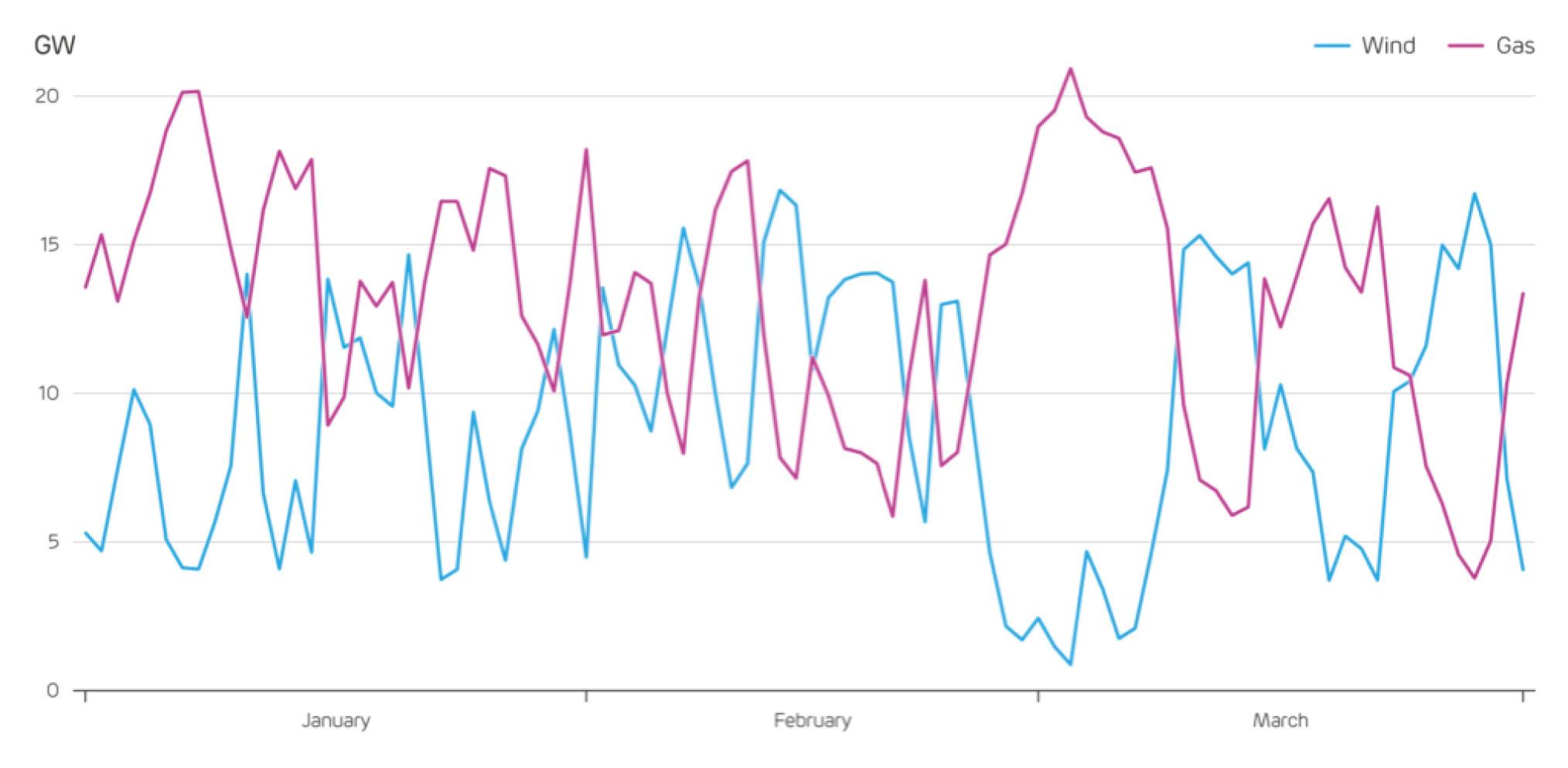
SOURCE: IAIN STAFFELL, ET AL., “Q1 2021 REPORT,” ELECTRIC INSIGHTS, 2021.
Germany, which has invested heavily in renewable energy through its energy transition (“Energiewende”), has recog nized these conditions as “dunkelflaute,” or dark doldrums. Although renewable power covered nearly half of Germany’s power consumption for all of 2020, during a four-day stretch in January, renewable generation never exceeded 14–20 percent of demand.50 The United Kingdom saw an extended calm spell in its wind generation during late February and early March 2021 when, for more than eleven days, wind farms operated at just 11 percent of their rated capacity (see Figure 3). The generation deficit represented 2,300 giga watt hours (GWh) of energy, more than two hundred and fifty times the energy stored in the UK’s largest pumped-storage facility, and ten thousand times the energy storable in the world’s largest battery-storage system in South Australia.51 Today, these deficits are typically covered with increased fossil generation. But, in the future, there will need to be dispatchable zero-emissions sources of power to address them. These conditions can extend over wide areas; even between Germany and Spain, despite their distance and dif ferent climates, there is roughly a one-third probability that the hours of low renewable generation coincide.52 Low wind
conditions across Europe during the summer of 2021, along with limited imports of gas from Russia and other factors, drove European power prices to what were then record highs, though since exceeded by price increases resulting from the war in Ukraine..53
For these and other reasons, many analyses have concluded that, in addition to renewable energy, dispatchable low-car bon generation technologies such as nuclear power, natu ral-gas power plants with carbon capture, and generation with zero-carbon or renewable fuels, such as hydrogen, will likely be needed as part of carbon-neutral electric-power systems.54 However, the potential to implement these tech nology options also varies by region, depending on the resources available.
Electrification of Energy Use
Options to decarbonize elements of the electric-power infra structure, although challenging, are further along in con cept, development, and potential availability than options to decarbonize distributed uses of fossil energy, such as
50 Benjamin Wehrmann, “‘Dark Doldrums’ Highlight Supply Challenges for Germany’s Fossil Power Phase-Out,” Clean Energy Wire, February 3, 2021, https://www.cleanenergywire.org/news/dark-doldrums-highlight-supply-challenges-germanys-fossil-power-phase-out.
51 Iain Staffell, et al., “Q1 2021 Report,” Electric Insights, 2021, https://reports.electricinsights.co.uk/reports/q1-2021.
52 “Nuclear Power in a Clean Energy System.”
53 Pippa Stevens, “UK Energy Titan SSE Says Low Wind, Driest Conditions in 70 Years Hit Renewable Generation,” CNBC, September 29, 2021, https://www.cnbc.com/2021/09/29/sse-says-low-wind-dry-conditions-hit-renewable-energy-generation.html.
54 Sepulveda, et al., “The Role of Firm Low-Carbon Electricity Resources in Deep Decarbonization of Power Generation.”
space heating and transportation. For that reason, contem plated approaches to broad energy decarbonization gener ally begin with shifting more energy requirements to elec tricity, or “electrification.” The IEA concludes that, to achieve broader energy decarbonization, electricity will replace fos sil fuels for industrial heat, transportation will rely primarily on electric drivetrains, and industrial processes will be con verted to rely on electric power or zero-carbon fuels. In that view, electricity will rise to 49 percent of final energy con sumption worldwide, compared to 20 percent today.55
Policies and corporate actions have begun to pursue the electrification objective. In the United States, President Joe Biden is aiming for half of new vehicles sold in 2030 to be some form of electric drive, and vehicle manufacturers from General Motors to Daimler have made commitments to shift their sales entirely to electric and hydrogen-powered vehi cles.56 The California Energy Commission has adopted stan dards that will strongly incentivize use of electric heat pumps for space and water heating in all new construction.57 The Inflation Reduction Act contains a number of incentives for electrification.
The addition of substantial vehicle charging and heating loads to the electric infrastructure will not only require more power, but will also change approaches to planning for resource adequacy and electric-system operation. Planning will now need to contemplate the timing of vehicle charging demands, potentially create incentives, and encourage tech nical management approaches to optimize them. Perhaps more challenging, electrification of space heating will require changing the planning mindset, since peak load require ments in some regions may shift to winter (see Figure 4). 58
Reliability and Resilience
The LNG supply shock throughout Asia in early 2021, men tioned earlier, is only one example of the challenges to main taining reliable energy supply as extreme weather events driven by climate change cause unanticipated demand and disrupt energy supply. The Asian gas-supply challenges of winter 2020–2021 evolved into a supply shortage and price spikes in both Asia and Europe before becoming dramatically worse as a result of Russia's invasion of Ukraine.
Figure 4: Peak Load by Season
55 “Net Zero by 2050.”
56 “Fact Sheet: President Biden Announces Steps to Drive American Leadership Forward on Clean Cars and Trucks,” White House, press release, August 5, 2021, https://www.whitehouse.gov/briefing-room/statements-releases/2021/08/05/fact-sheet-president-biden-announces-steps-to-drive-american-leadership-forward-onclean-cars-and-trucks; Neal E. Boudette and Coral Davenport, “G.M. Will Sell Only Zero-Emission Vehicles by 2035,” New York Times, January 28, 2021, https://www.nytimes.com/2021/01/28/business/gm-zero-emission-vehicles.html; Jack Ewing, “World’s Largest Long-Haul Truckmaker Sees Hydrogen-Fueled Future,” New York Times, May 23, 2021, https://www.nytimes.com/2021/05/23/business/hydrogen-trucks-semis.html.
57 Kavya Balaraman, “California Greenlights First-of-Its-Kind Energy Code to Encourage Electrified Buildings,” Utility Dive, August 12, 2021, https://www.utilitydive.com/news/california-greenlights-first-of-its-kind-energy-code-to-encourage-electrifi/604863.
58 “Electrification Futures Study,” National Renewable Energy Laboratory, https://www.nrel.gov/analysis/electrification-futures.html.

In the United States, events in California and Texas high lighted similar vulnerabilities. During the summer of 2020 in California, there were rolling blackouts over the course of several days driven by a heatwave that extended across the western United States.59 A variety of factors contributed to the event, including retiring fossil generation before replace ment supply was put in place, lack of clear accountability because of the shared roles of various state agencies, and overreliance on imports from outside California, which were not available because widespread weather conditions left the entire region short of supply.60 Contracts for new capac ity intended to meet peak demand, much of it battery stor age, have since been accelerated. Much of the region con tinues to face potential shortfalls of peak capacity and to continue “over-reliance on imports to maintain resource adequacy.”61 In late summer 2022, California experienced another extreme heatwave and record power demand, but avoided rolling outages through a successful emergency public appeal to reduce power use.
In February 2021 in Texas, more than one hundred and fifty people died, millions of people lost access to clean water, and there was widespread property damage during extreme winter weather. Initially, state officials blamed the unreliabil ity of renewable energy. However, it soon became clear that unavailable fossil-powered generation accounted for most of the shortfall. The causes turned out to include a failure to weatherize all types of power plants—including natural gas, wind, and nuclear—as well as natural-gas pipeline systems. In addition, there were gas shortages caused by rising demand throughout the country during the cold spell, and an overall lack of coordination.62 The experience clarified that even nat ural-gas power plants may not be reliable if gas-supply net works are not robust, a situation similar, in some ways, to the Japanese experience in early 2021, though the cause of the fuel-supply challenges was different.
The recognition that power systems must change to rely more on variable renewable power, and that climate change will alter the conditions under which power-system reliabil ity is tested, has caused a reconsideration of approaches to
reliability. In the past, weather was considered only as a fac tor driving demand, and resource adequacy focused on man aging discrete, independent mechanical or electrical failures, such as generating-unit outages. In the future, with more vari able resources supplying power, weather will drive both sup ply and demand, and correlated weather-related events will determine reliability.63 As a result, the conventional approach of designing a system to meet peak-load conditions with a static reserve margin will no longer be appropriate, and a chronological evaluation of all hours of the planning period will be required so the periods of shortfall can be identified.64
Furthermore, climate change means that historical weather conditions may not accurately predict future conditions. During the California heatwave, some of the highest tempera tures in the past thirty-five years were recorded across the entire western United States. Similarly, during the 2021 winter storm, Texas experienced near-record low temperatures. 65
The combination of increased reliance on variable renewable generation, and the need to anticipate potentially increased volatility in weather-related demand, requires a stronger commitment to energy storage and fuel reserves. In the past, fuel reserves have been considered only in the context of fossil fuel, whether in storage facilities or in the ground wait ing to be produced. In the future, storage will need to include long-term power storage (such as advanced batteries that are only now being demonstrated) and potentially hydrogen (though hydrogen storage may be challenging without favor able geography). These conditions also argue for the value of dispatchable zero-carbon energy resources, particularly nuclear power, which because of its long fuel cycles main tains extensive power reserves onsite (conventional reac tors have refueling cycles more than a year long, and some advanced reactors have even longer cycles or can continu ously refuel).
Future planning for reliability and resilience will need to be much more complete, and incorporate a wide range of fac tors, including
59 “2021 Summer Readiness,” California Independent System Operator, http://www.caiso.com/about/Pages/News/SummerReadiness.aspx.
60 Ivan Penn, “Poor Planning Left California Short of Electricity in a Heat Wave,” New York Times, August 20, 2020, https://www.nytimes.com/2020/08/20/business/ energy-environment/california-blackout-electric-grid.html; Cheryl A. Lafleur, “What’s Ailing California’s Electric System?” Columbia Climate School, September 2, 2020, https://news.climate.columbia.edu/2020/09/02/whats-ailing-californias-electric-system; Jeff St. John, “California’s Race to Secure Its Grid Against Summer Blackouts,” Canary Media, May 19, 2021, https://www.canarymedia.com/articles/californias-race-to-secure-its-grid-against-summer-blackouts/.
61 St. John, “California’s Race to Secure Its Grid Against Summer Blackouts.”
62 Edward Kump, Mike Lee, and Carlos Anchondo, “Documents Reveal Natural Gas Chaos in Texas Blackouts,” Energywire, May 20, 2021, https://www.eenews.net/stories/1063733071.
63 For example, to address the loss of wind generation in March 2021, gas-fired generation in Britain increased 20 percent in the first quarter of 2021 compared to the same quarter in the prior year. Staffell, et al., “Q1 2021 Report.”
64 “Redefining Resource Adequacy for Modern Power Systems,” Energy Systems Integration Group, 2021, https://www.esig.energy/resource-adequacy-for-modern-power-systems.
65 Ibid.
• correlated load and supply variability due to weather con ditions, overextended geographical areas to account for potential limitations on imports (traditionally resource ade quacy has focused only on the load variability);
• weather conditions outside normal or historical bounds;
• probabilistic likelihood of mechanical failures (this is tradi tionally the focus of reliability analysis);
• transmission constraints (also a traditional concern); and
• charging and discharging energy-limited storage resources.
Future power systems will need to consider the characteris tics of specific components that support reliability and resil ience, including demand management, which may be greatly expanded as a result of digital control over the timing of cer tain elements of demand (e.g., space and water heating, vehi cle charging). In addition, they will need to consider resilience of the power-supply system, both to direct weather impacts and fuel supply. Such considerations will place a premium on resilient supply options.
III. Implications for the United States
Decarbonization in the United States
In the United States, carbon-dioxide emissions from electric power have declined substantially in recent years, due to the substitution of gas-fired generation for coal-fired generation. Between 2005 and 2019, the share of generation from coal declined from 50 percent to 23 percent, while the share from gas increased from 19 percent to 38 percent, and carbon-di oxide emissions from the power sector fell by 32 percent.66 Growth in generation from renewable sources has acceler ated, with generation from wind power almost doubling in the
five years through 2020, and generation from solar almost quadrupling (see Figure 5, US Electric Generation by Fuel). 67
With vast land areas, including plains with consistent winds and deserts with consistent sunlight, the United States enjoys an enormous potential for renewable generation. The tech nical potential for US renewable generation is tens to hun dreds of times larger than its current electric demand.68 Many studies have been done of the potential to decarbonize electric generation and overall energy supply in the United States. A review by the US National Academies of Sciences, Engineering and Medicine (NASEM) concluded that five near-
Figure 5: US Electric Generation by Fuel
66 “Electric Power Sector CO2 Emissions Drop as Generation Mix Shifts from Coal to Natural Gas,” US Energy Information Administration, June 9, 2021, https://www.eia.gov/todayinenergy/detail.php?id=48296. Over that time period, renewable generation (including conventional hydroelectric) grew from 9 percent to 18 percent, driven primarily by increased wind generation, while nuclear generation held steady at 20 percent. Total generation was relatively constant.
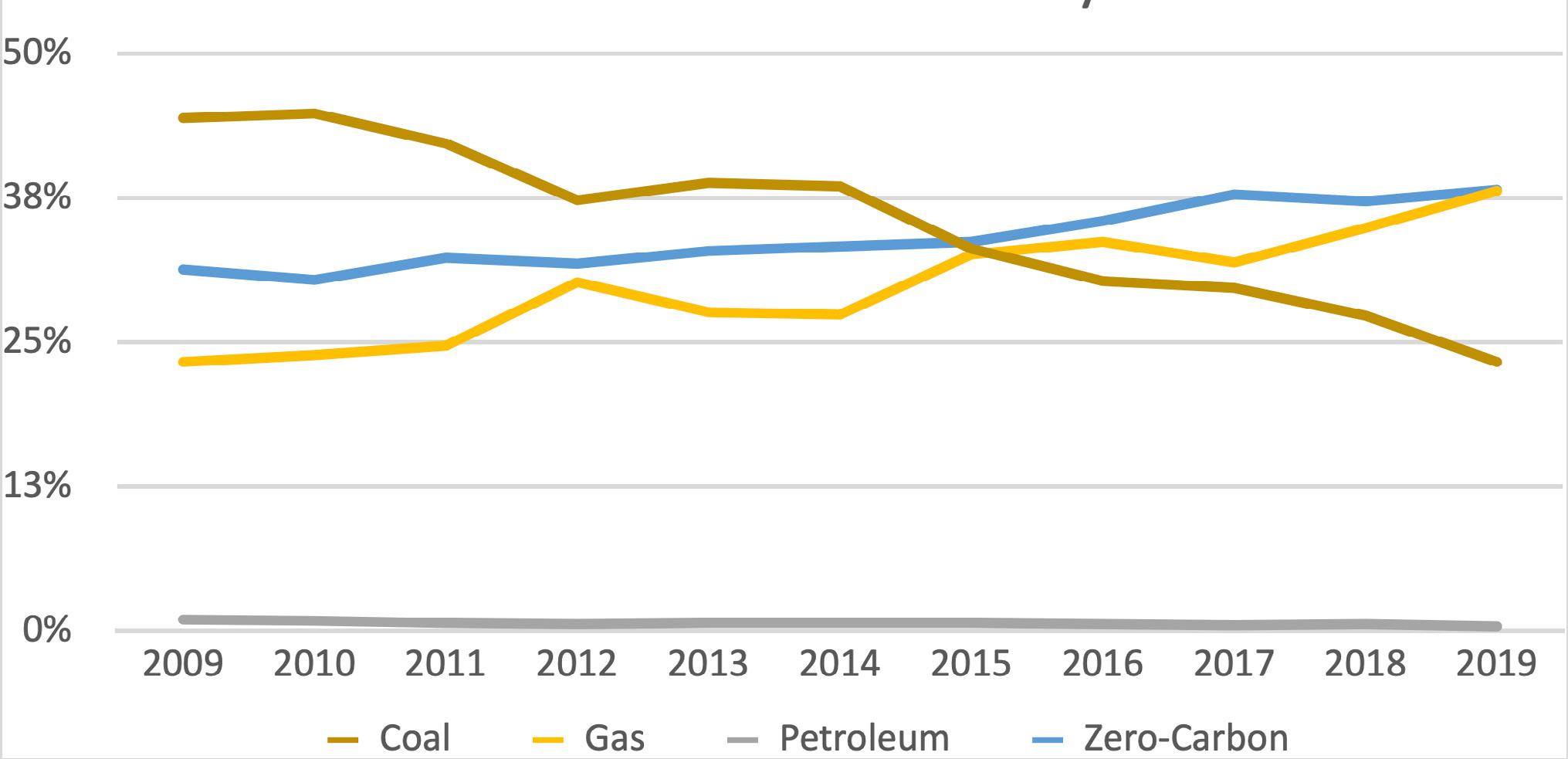
67 “Monthly Energy Review,” US Energy Information Administration, table 7.2A, https://www.eia.gov/totalenergy/data/browser/index.php?tbl=T07.02A#/?f=A&start=1949&end=2020&charted=8-10-11-12-13-14
68 Anthony Lopez, et al., “U.S. Renewable Energy Technical Potentials: A GIS-Based Analysis,” National Renewable Energy Laboratory, July 2012, https://www.nrel.gov/ docs/fy12osti/51946.pdf. Total US power generation averages around 4,000 terawatt-hours (TWh); in this report the technical wind potential was estimated at about 50,000 TWh and the technical solar potential at over 280,000 TWh; the estimate would likely be higher today due to improvements in the technologies.
term actions were common to the approaches in the studies they reviewed, including:
1. improve energy efficiency;
2. electrify energy requirements for transportation, build ings, and industry;
3. decarbonize electricity production, including deploy ment of wind and solar generation at a fast pace (match ing or exceeding record historical levels) and continued or accelerated retirement of coal generation;
4. improve infrastructure, including electric transmission capacity (increasing it by as much as 60 percent by 2030), electric-vehicle charging capacity, and CO2 transport and storage (for carbon capture);
5. ongoing research and development (R&D) in several areas to expand technical options, such as for advanced nuclear energy and other zero-carbon dispatchable gen eration, hydrogen production, and zero-carbon options for shipping and industry.69
The NASEM review found that the studies generally incor porated increases in clean electric generation from 37 per cent in 2020 to as much as 75 percent by 2030, including the addition of 250–350 GW each of wind and solar gener ation, with clean generation reaching 85 percent or more by 2050. Other studies have also highlighted the variety of scenarios through which US energy decarbonization could be achieved, and the wide range of electric generation and other technologies likely to be required to do so.70
Challenges to Deployment of Renewable Energy
Despite the extensive resource base and the potential for renewable generation to provide the foundation for a decar bonized power system, expansion of renewable generation in the United States at the pace anticipated in decarboniza tion projections may be challenging. While renewable gen eration is attractive in the abstract, it is distributed over large land areas and, therefore, can have a widespread impact on communities.71 Wind power has generated local opposi tion throughout the Midwest, and solar projects have faced opposition in both western deserts and eastern farmlands.72
Although the United States has extensive renewable resources, they are widely dispersed, and the best resources are distant from energy demand (see Figure 6). One study found that about 90 percent of US wind power potential, and almost 60 percent of its solar-power potential, was in the fifteen-state region between the Mississippi River and the Rocky Mountains, but that 70 percent of electric demand would be from outside that region.73 As a result, increas ing reliance on renewable energy may also require greatly expanding electric transmission. One major study of US decarbonization options projected that transmission capacity would need to more than triple by 2050.74 Expanding trans mission capacity is often challenging because of the impact on the landscape and communities all along the routes. Transmission expansion is particularly difficult in the United States because it requires state-by-state approvals and can face resistance from entrenched interests, and a number of long-distance transmission projects to support renewable generation have been unsuccessful.75
69 “Accelerating Decarbonization of the U.S. Energy System,” National Academies of Sciences, Engineering, and Medicine, 2021, https://www.nap.edu/catalog/25932/accelerating-decarbonization-of-the-us-energy-system.
70 Lindsey Walter, Lesley Jantarasami, and Conrad Schneider, “Pathways to Net-Zero Emissions,” Decarb America, February 4, 2021, https://decarbamerica.org/report/pathways-to-net-zero-emissions.
71 Samantha Gross, “Renewables, Land Use, and Local Opposition in the United States,” Brookings, January 2020, https://www.brookings.edu/research/renewables-land-use-and-local-opposition-in-the-united-states/.
72 Emily Pontecorvo, “We Need to Build a Lot of Wind Turbines. Will Americans Agree to Live Near Them?” Grist, January 22, 2021, https://grist.org/energy/we-need-to-build-a-lot-of-wind-turbines-will-americans-agree-to-live-near-them/
73 Alexandra Rekkas, “Transmission Upgrades & Expansions: Keys to Meeting Large Customer Demand for Renewable Energy,” David Gardiner and Associates, January 16, 2018, https://www.dgardiner.com/wef-dga-report-transmission-needed-meet-corporate-americas-growing-demand-renewable-power/
74 “Net-Zero America,” Princeton University, https://netzeroamerica.princeton.edu/
75 Robinson Meyer, “Unfortunately, I Care About Power Lines Now,” Atlantic, July 28, 2021, https://www.theatlantic.com/science/archive/2021/07/america-is-bad-at-building-power-lines-lets-fix-that-transmission-climate/619591/. Russell Gold, “Building the Wind Turbines Was Easy. The Hard Part Was Plugging Them In,” Wall Street Journal, June 22, 2019, https://www.wsj.com/articles/building-the-wind-turbines-was-easy-the-hard-part-was-plugging-them-in-11561176010; “Maine Voters Reject Quebec Hydropower Transmission Line,” Reuters, November 3, 2021, https://www.reuters.com/world/americas/maine-voters-reject-quebec-hydropower-transmission-line-2021-11-03/.
Of course, there is much policy interest in addressing the challenges to deploying renewable energy and expanding transmission capacity at the pace required to achieve decar bonization goals. These challenges also place a premium on ensuring other low-carbon-generating options, including nuclear power, continue to be developed and considered, so the pace of decarbonization can achieve climate-preser vation objectives.
Nuclear Power in the United States
Nuclear power has consistently provided the greatest share of zero-carbon electricity in the United States (see Figure 7). Through research, testing, and experience, existing US power plants have also improved their operations, both increasing their capacity factor (the percentage of output
available throughout the year) and implementing power uprates, both of which enable increased zero-carbon gener ation from existing assets.76 However, existing nuclear-power generation in the United States faces economic challenges driven by additions of natural gas and renewable generat ing capacity, the rules governing electric markets, and, until recently, historically low natural-gas prices. More than 8,400 megawatts of nuclear generation have retired prematurely since 2013.77 In April 2022, the US Department of Energy began seeking applications for the $6-billion Civil Nuclear Credit Program, which was authorized and funded under the Bipartisan Infrastructure Law, to preserve the clean energy from existing nuclear power plants.78 The Inflation Reduction Act includes tax credits that will support existing reactors as well as provide incentives for new advanced nuclear energy options.
Figure 6: The Best US Renewable Resources Are Distant from Many Population Centers
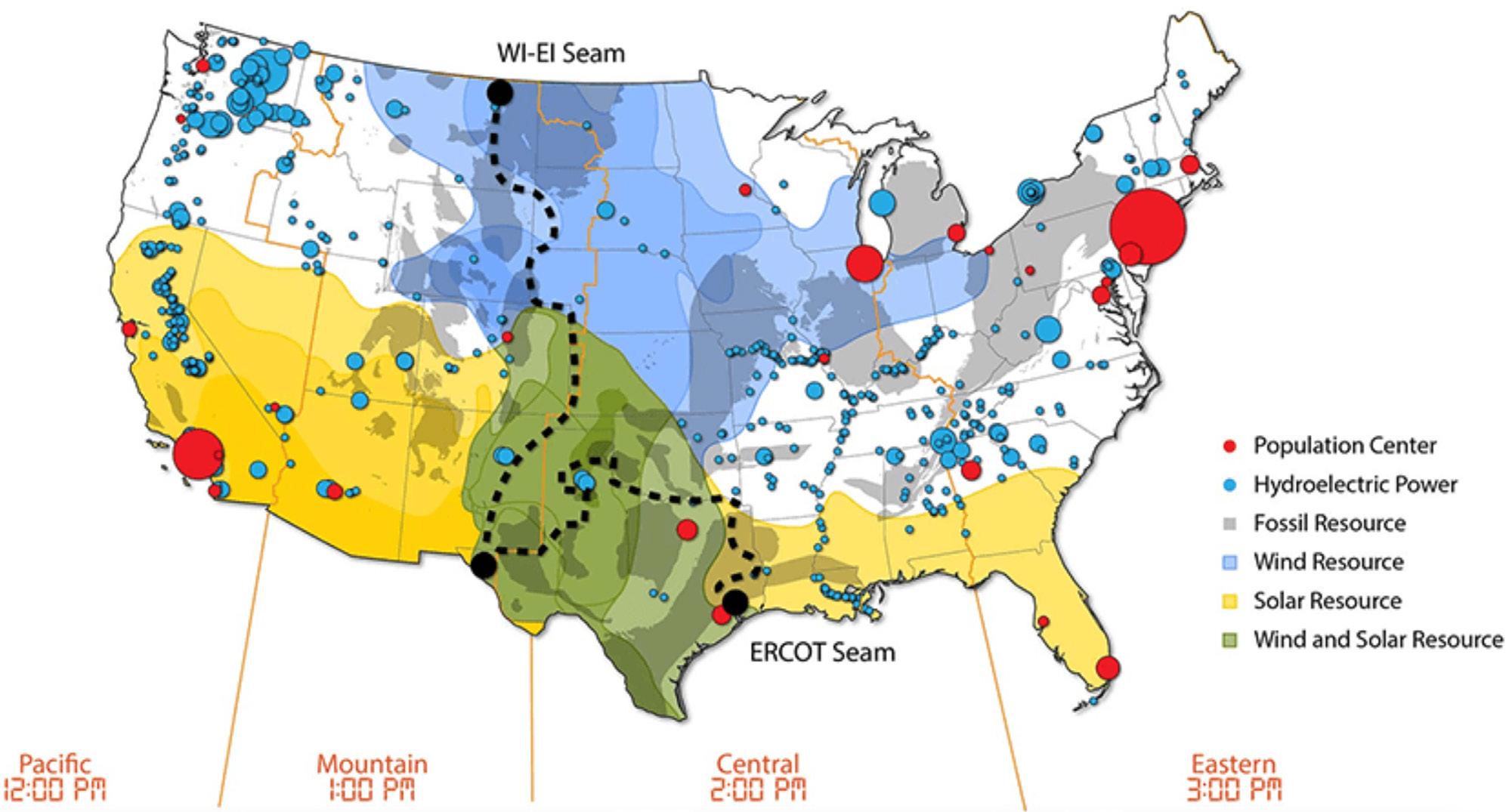
SOURCE: “INTERCONNECTIONS SEAM STUDY,” NATIONAL RENEWABLE ENERGY LABORATORY, HTTPS://WWW.NREL.GOV/ANALYSIS/SEAMS.HTML.
Reprinted with permission from the National Renewable Energy Laboratory, https://www.nrel.gov/docs/fy21osti/78161.pdf, accessed Septem ber 19, 2022. The figure appears on page 11 of this linked publication and will be a cleaner citation than pointing to the web page which could change.
Please note that the NREL developed figure is not to be used to imply an endorsement by NREL, the Alliance for Sustainable Energy, LLC, the operator of NREL, or the US Department of Energy.
76 “U.S. Nuclear Industry Capacity Factors,” Nuclear Energy Institute, https://www.nei.org/resources/statistics/us-nuclear-industry-capacity-factors; “U.S. Nuclear Industry Yearly Power Uprates and Capacity Additions,” Nuclear Energy Institute, https://www.nei.org/resources/statistics/us-industry-yearly-uprates-and-capacity-additions.
77 Stephen S. Greene, Advancing US-ROK Cooperation on Nuclear Energy, Atlantic Council, March 2, 2021, https://www.atlanticcouncil.org/in-depth-research-reports/report/advancing-us-rok-cooperation-on-nuclear-energy/
78 “DOE Seeks Applications, Bids for $6 Billion Civil Nuclear Credit Program,” US Department of Energy, press release, April 19, 2022, https://www.energy.gov/articles/doe-seeks-applications-bids-6-billion-civil-nuclear-credit-program.
While gigawatt-scale conventional nuclear reactors continue to be constructed around the world (e.g., in Russia, China, South Korea, and the United Arab Emirates), the future of nuclear power in the United States appears to be focused on advanced nuclear technologies. A recent study concluded that advanced nuclear technologies could provide 20 to 50 percent of US electric generation by 2050.79
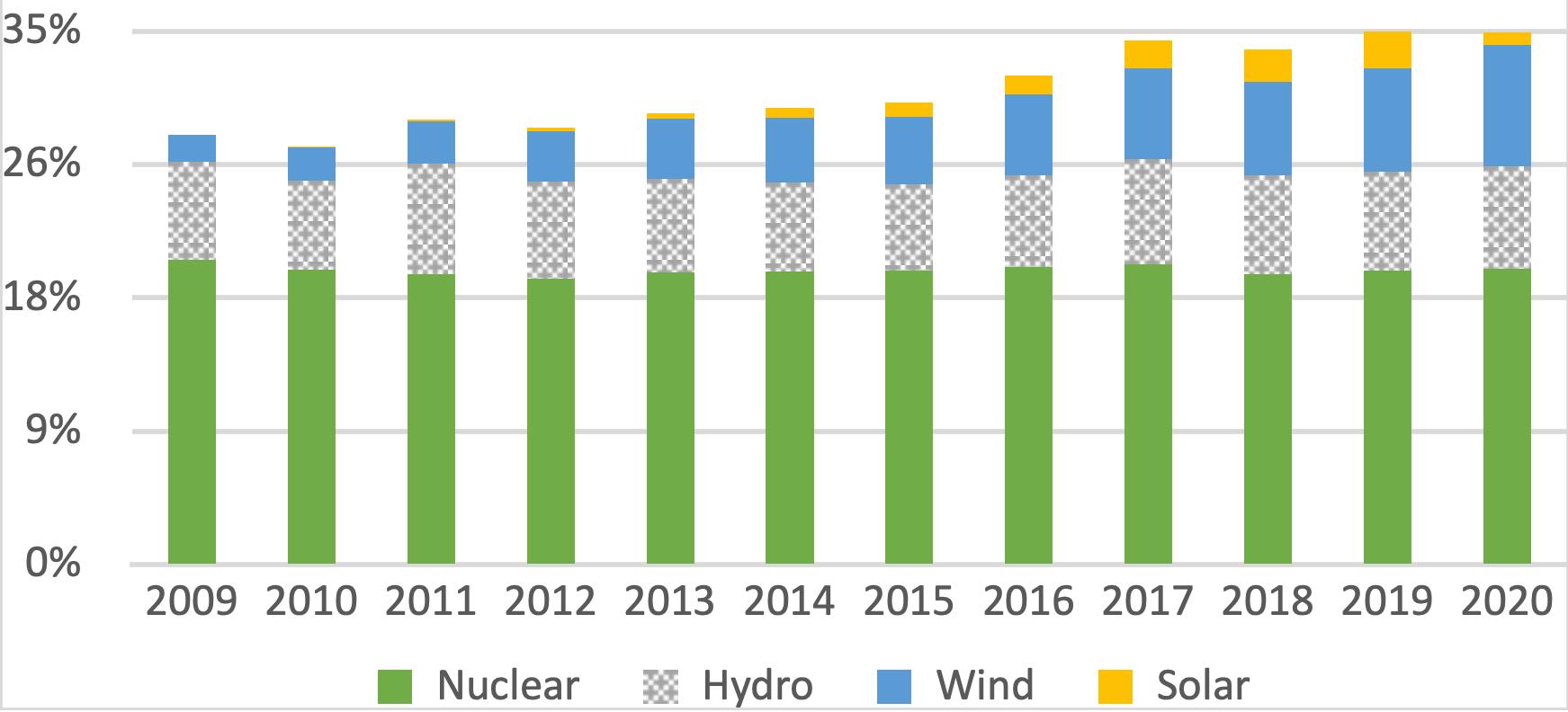
The US government supports advanced nuclear technolo gies, most visibly through the Department of Energy’s ARDP. This program has awarded partial funding—expected to total more than $3 billion—for two demonstration projects expected to result in operating reactors within seven years.80 The program has also awarded funding in smaller increments for “risk reduction” projects and advanced-reactor concept work on designs that could be demonstrated over a longer time period. 81 In addition to the ARDP and the tax credits included in the Inflation Reduction Act, which provide incen tives for nuclear energy on par with those previously offered
to renewables, several legislative efforts have been taken to support advanced nuclear energy. These include provi sions in the Energy Act of 2020 to support fuel availability for advanced reactors and research, development, demon stration, and commercialization programs for nuclear energy, and the reintroduction of the American Nuclear Infrastructure Act (ANIA), which would authorize the Nuclear Regulatory Commission (NRC) to support international nuclear regula tory cooperation, support licensing of advanced reactors, and update ownership provisions for nuclear reactors to per mit investment from entities in allied countries. 82
The administration’s efforts explicitly include nuclear power as part of the approach to decarbonization. Financial incen tives for nuclear power are part of the legislative efforts sup porting the decarbonization agenda, and Secretary of Energy Jennifer Granholm has said, “Carbon-free nuclear power is an absolutely critical part of our decarbonization equation.”83
Figure 7: Carbon-Free Generation in the United States
Key sources of carbon-free electric generation in the United States as a fraction of total generation. Excludes biomass and geothermal generation.
SOURCE DATA: “STATISTICAL REVIEW OF WORLD ENERGY,” BP, 2021, HTTPS://WWW.BP.COM/EN/GLOBAL/CORPORATE/ENERGY-ECONOMICS/STATISTICAL-REVIEW-OF-WORLD-ENERGY.HTML.
79
80 “U.S. Department of Energy Announces $160 Million in First Awards under Advanced Reactor Demonstration Program,” US Department of Energy, press release, October 13, 2020, https://www.energy.gov/ne/articles/us-department-energy-announces-160-million-first-awards-under-advanced-reactor
81 “Advanced Reactor Demonstration Program,” US Department of Energy, https://www.energy.gov/ne/advanced-reactor-demonstration-program
82 “Advanced Reactors in the Energy Act of 2020 and the New Administration,” Nuclear Innovation Alliance, January 2021, https://nuclearinnovationalliance.org/advanced-reactors-energy-act-2020-and-new-administration; Amy Roma and Stephanie Fishman, “American Nuclear Infrastructure Act Makes a 2021 Comeback,” Hogan Lovells, July 20, 2021, https://www.hlnewnuclear.com/2021/07/american-nuclear-infrastructure-act-makes-a-2021-comeback/
83 “USA Needs Nuclear to Achieve Net Zero, Says Granholm,” World Nuclear News, June 17, 2021, https://www.world-nuclear-news.org/Articles/USA-needs-nuclear-to-achieve-net-zero-says-Granhol
IV. Implications for Japan
Decarbonization in Japan
Japan’s energy-supply portfolio and prospects for decar bonization were dramatically changed by its response to the Great East Japan Earthquake, and the resulting failure of the Fukushima Daiichi Power Plant, in 2011. In 2010, more than 30 percent of Japan’s electric generation was carbon free, substantially due to the amount of nuclear power, compar ing favorably to other large economies (see Figures 8 and 9). By 2012, only 10 percent of Japan’s generation was car bon free. Carbon-free generation has risen to about 20 per
cent on the strength of a strong commitment to solar power, despite limited resumption of nuclear-plant operations, but Japan remains well behind other large economies.
More important, perhaps, is the change in Japan’s energy aspirations post-Fukushima. In 2010, projections of electric supply for the year 2030 anticipated that 49 percent of elec tricity would come from nuclear power and 19 percent from renewables, a total of 68 percent of supply from zero-car bon sources, which, at the time of those projections, would have anticipated one of the least carbon-intensive energy supplies in the world. By 2015, projections aspired to 44
Figure 8: Carbon-free electric generation in selected countries as a fraction of total generation
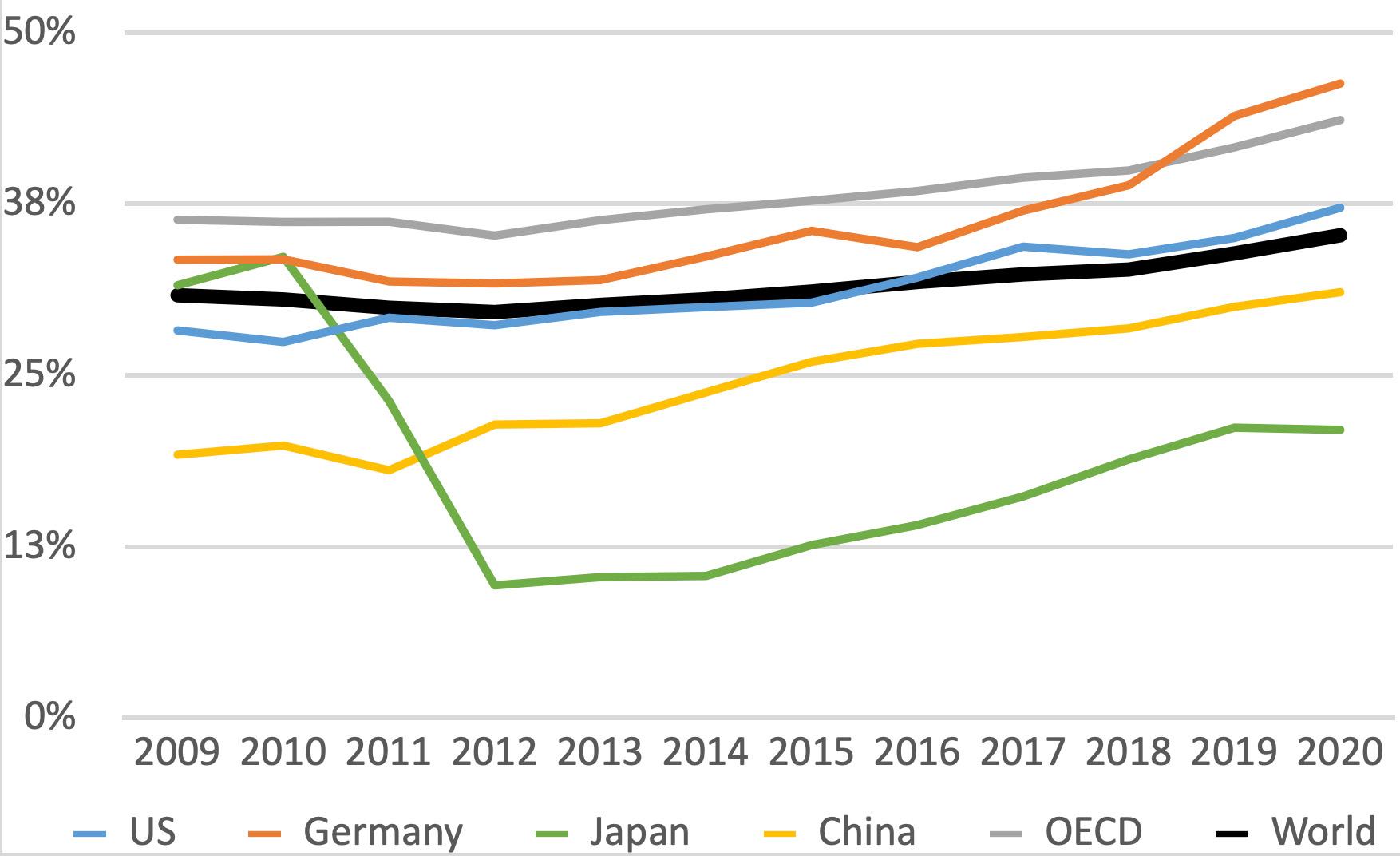
*For simplicity, calculated as the sum of nuclear, hydroelectric, wind, and solar generation divided by total electric generation. Note, France is around 90 percent as a result of its substantial nuclear generation, raising the Organisation for Economic Co-operation and Development (OECD) average.
SOURCE DATA: “STATISTICAL REVIEW OF WORLD ENERGY.”
Figure 9: Key sources of carbon-free electric generation in Japan as a fraction of total generation
percent of supply from zero-carbon sources and anticipated an 82-percent increase in the electric generation from fos sil fuels compared to the 2010 plan. In October 2021, the government of Japan approved the Sixth Strategic Energy Plan, in which zero-carbon sources are projected to sup ply 59 percent of total electric generation.84 In addition, the electric-generation requirement is expected to be reduced 8 percent from fiscal year 2019 (FY2019) through greater effi ciency, which will be very challenging given the need to elec trify a greater proportion of total energy requirements to facil itate decarbonization.
The draft Strategic Energy Plan was aligned to former Prime Minister Yoshihide Suga’s April pledge to achieve a 46-per cent reduction in Japan’s carbon emissions by 2030. 85 The
plan incorporates a substantial expansion of renewable energy compared to previous plans; renewable genera tion would support 36–38 percent of total generation in this plan, compared to the 2015 outlook of 22–24 percent, which could be challenging considering Japan’s renewable costs and resource base (discussed further below). The draft plan counts on nuclear power to deliver 20–22 percent of require ments, which is only achievable if it requires restarts of most of the ten reactors for which review is currently pending, as well as the seven that have received permission to restart but have not yet done so.86 Nuclear power contributed only about 6 percent of electric generation in 2019. Under the plan, Japan would continue to rely on coal-fired capacity for 19 percent of generation in 2030 and LNG for 20 percent, all of which would require carbon capture, fuel substitution, or
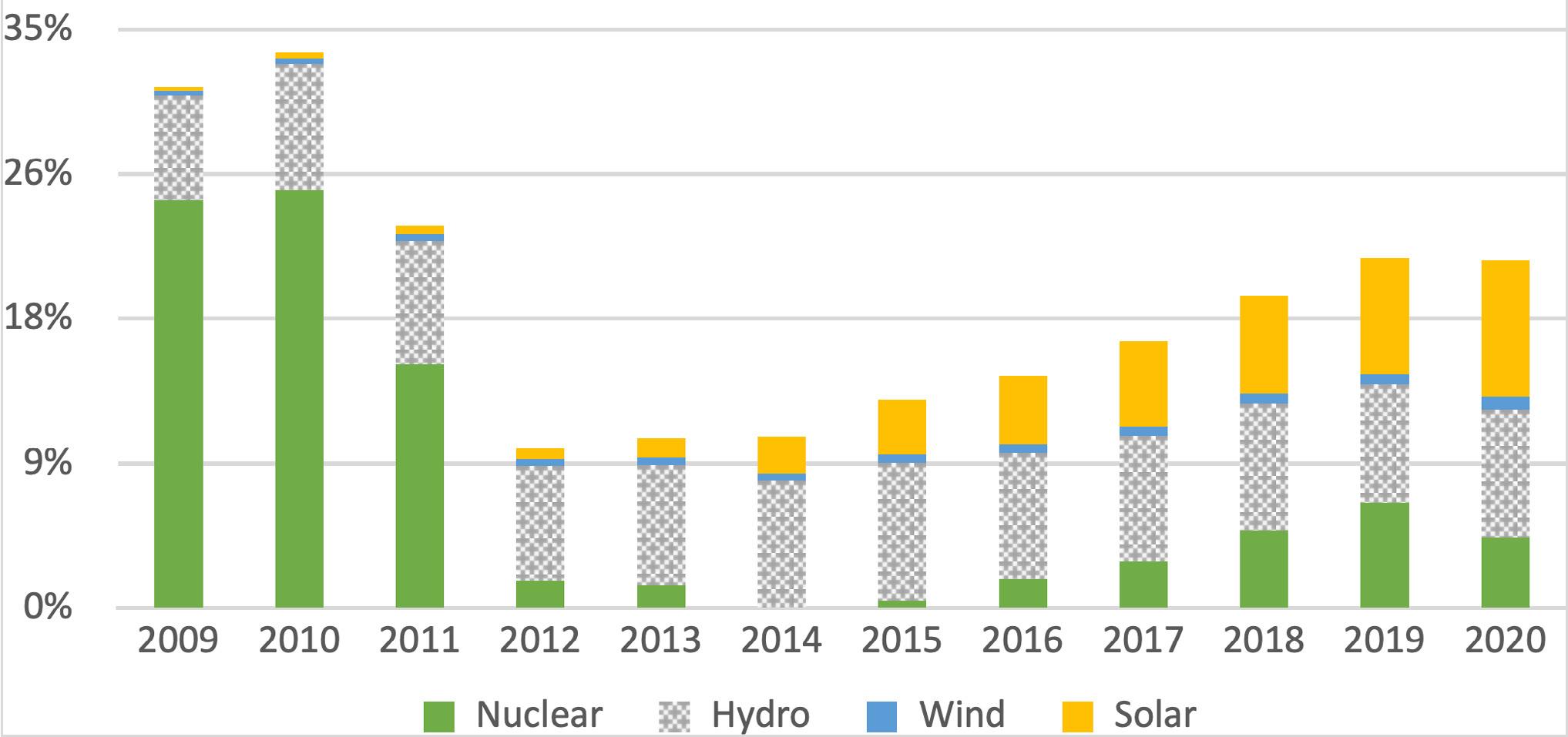
84 “Cabinet Decision on the Sixth Strategic Energy Plan,” Ministry of Economy, Trade, and Industry of Japan, October 22, 2021, https://www.meti.go.jp/english/press/2021/1022_002.html; Masakazu Toyoda, “The Role of Nuclear Power for Carbon Neutrality, A Japanese Perspective,” The Institute of Energy Economics, Japan (IEEJ), May 2021; “Japan’s New 2030 Energy Mix Unveils Radical Plans to Transform the Energy System,” Wood Mackenzie, July 2021, https://www.woodmac.com/press-releases/japans-new-2030-energy-mix-unveils-radical-plans-to-transform-the-energy-system/; Takeo Kumagai, “Japan Set for 60% Non-Fossil Fuel Power Supply in 2030 in GHG Slash Drive,” S&P Global Commodity Insights, July 21, 2021, https://www.spglobal.com/platts/en/market-insights/latest-news/electric-power/072121-japan-set-for-60-non-fossil-fuel-power-supply-in-2030-in-ghg-slash-drive
85 Kikkawa Takeo, “The Road to Carbon Neutrality and the Issues of the 6th Strategic Energy Plan,” Japan Foreign Policy Forum, August 30, 2021, https://www.japanpolicyforum.jp/economy/pt2021083013564211429.html.
86 Ibid.
replacement by 2050 to attain the plan’s 2050 goal of car bon neutrality.87
In response to the energy crises driven by Russia's inva sion of Ukraine, Prime Minister Fumio Kishida, who replaced Suga in late 2021, called for ensuring the operations of the ten nuclear reactors that had restarted, maximizing efforts to restart additional reactors, and extending the opera tions of existing reactors. He also noted that construction of next-generation reactors should be considered in the future.
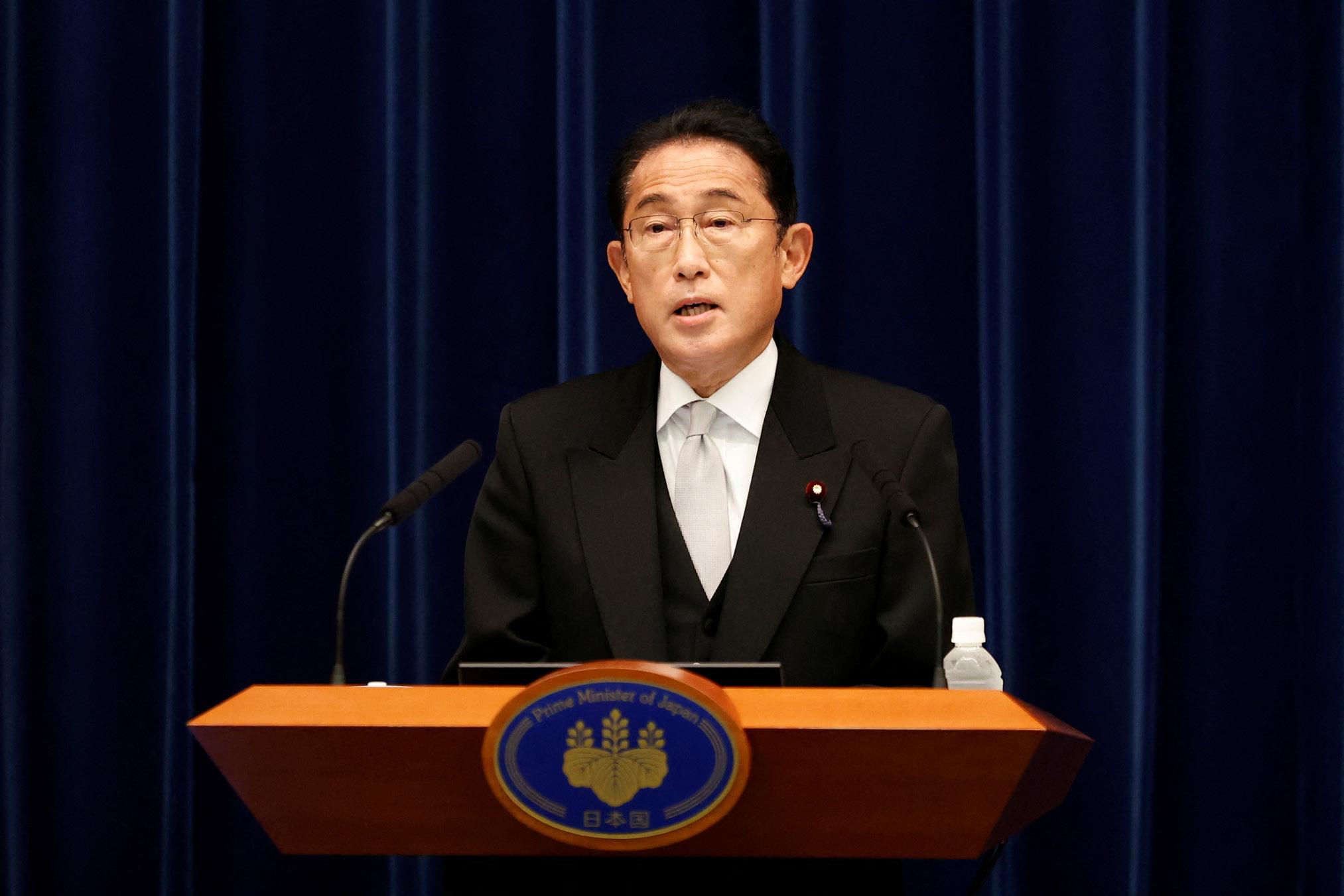
The Research Institute of Innovative Technology for the Earth (RITE) provided analysis to support the development of the Strategic Energy Plan.88 The RITE analysis highlights several challenges to Japan’s ability to achieve carbon neutrality by 2050.
Challenges to Renewable Generation
First, the RITE scenarios anticipate renewable generation sufficient to provide 44–63 percent of power generation in 2050 (in addition to one scenario in which renewables were exogenously assumed to cover 100 percent). The study con cluded that, in Japan, achieving levels of renewable gen eration higher than those in these scenarios may be diffi cult. The study found that, while costs have declined over time as they have elsewhere in the world, renewable costs in Japan remain significantly higher than worldwide averages. According to data from the International Renewable Energy Agency (IRENA), the installed cost of solar in Japan is about 1.7 times greater than it is in the United States, and about 2.6 times greater than in Germany; a significant area of differ ence is the cost of installation.89
87 The results of the leadership election could have a meaningful near-term influence on the role of nuclear power in Japan, as Kishida defeated Taro Kono, who is strongly antinuclear.
88 “‘Scenario Analyses for 2050 Carbon Neutrality in Japan’ Provided to the Advisory Committee for Natural Resource and Energy (Including Additional Information),” Research Institute of Innovative Technology for the Earth, June 11, 2021, https://www.rite.or.jp/system/en/latestanalysis/2021/06/2050carbonneutrality.html
89 “Renewable Power Generation in 2020,” International Renewable Energy Agency, June 2021, https://www.irena.org/publications/2021/Jun/Renewable-Power-Costs-in-2020.
Figure 11: Power Grid of Japan as of September 30, 2019
SOURCE: “NATIONAL TRUNK LINE CONNECTIONS,” FEDERATION OF ELECTRIC POWER COMPANIES OF JAPAN, LAST UPDATED SEPTEMBER 30, 2019, HTTPS://WWW.FEPC.OR.JP/ENGLISH/ENERGY_ELECTRICITY/COMPANY_STRUCTURE/SW_INDEX_02/INDEX.HTML.
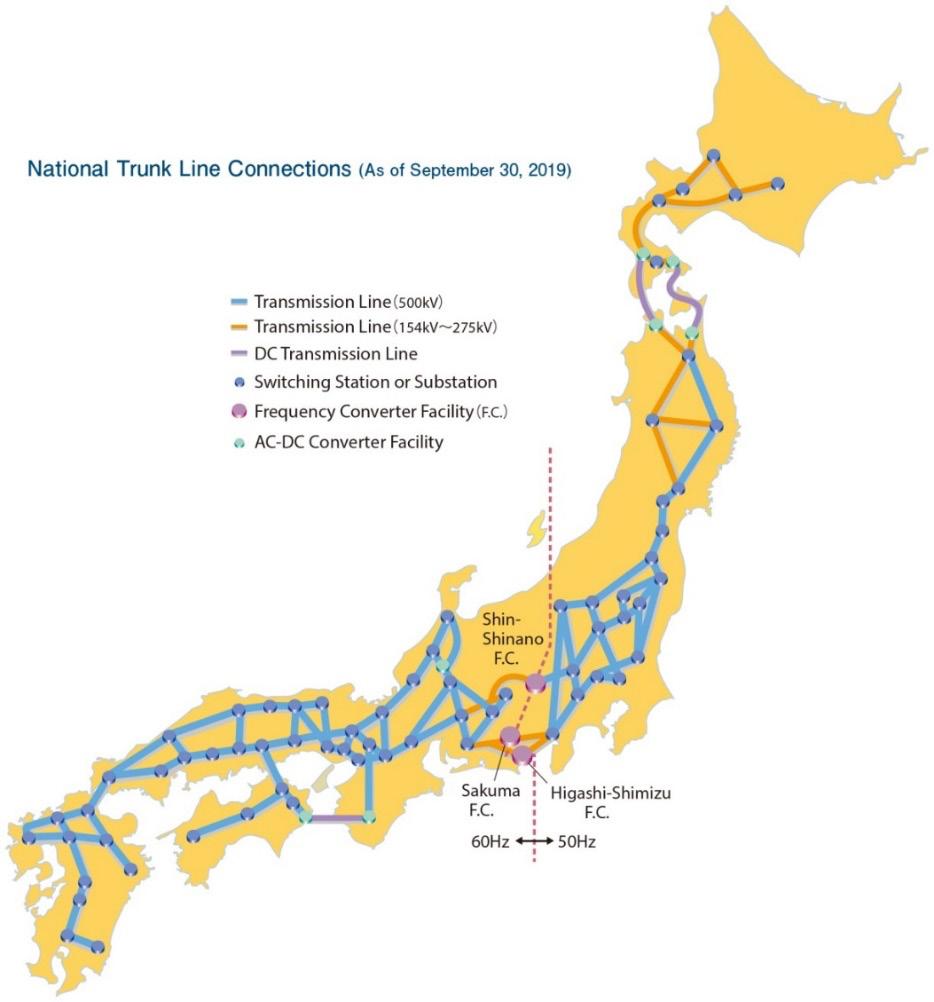
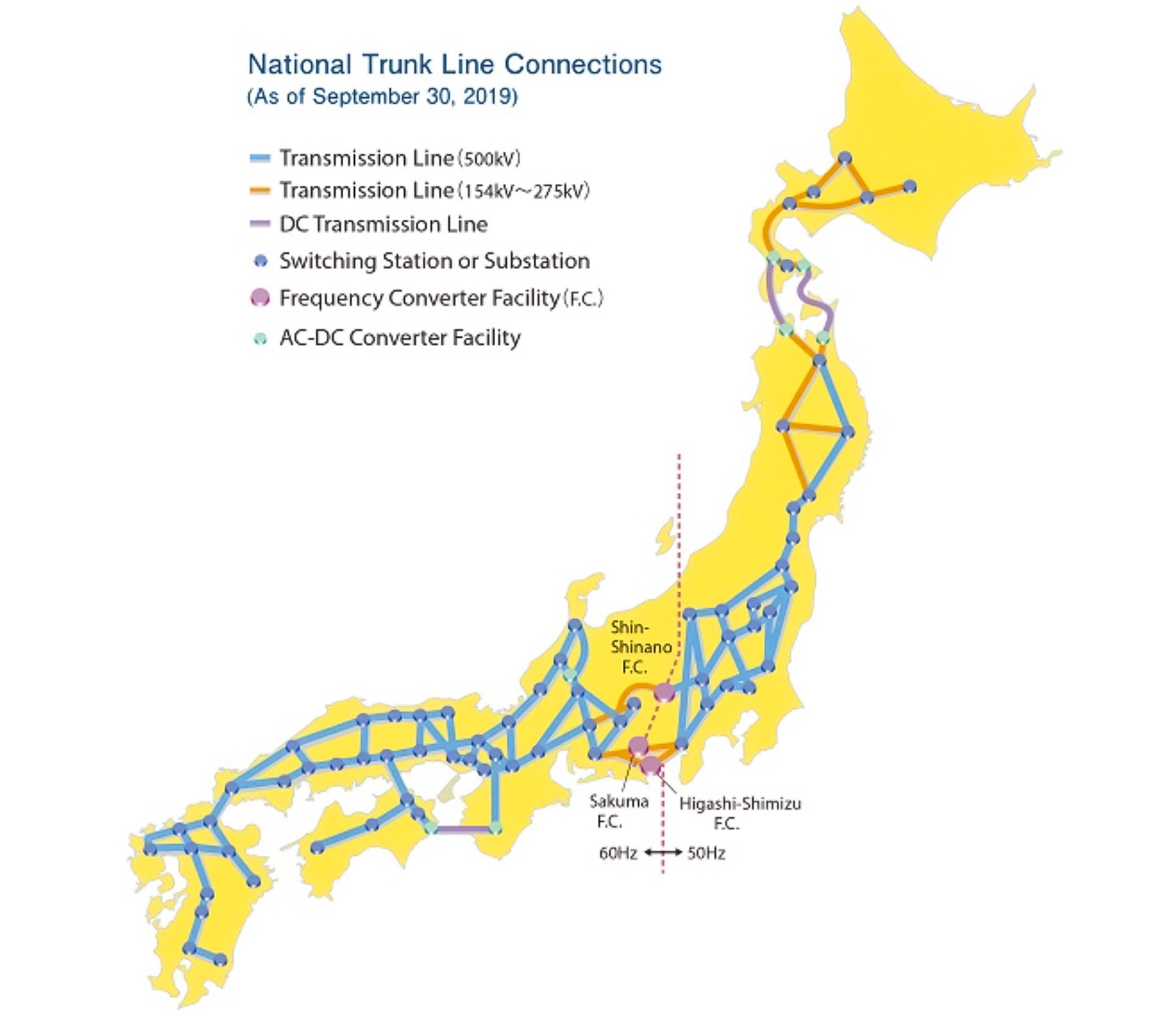
There are several challenges to achieving high levels of renewable generation in Japan. The costs of integrating renewable resources into the grid are high, even at mod est penetration levels. The RITE study cites integration costs for solar power of $100 per megawatt hour if it provides 40 percent of total power generation, then escalating rapidly beyond that, and the same costs for wind power at only 25
percent of generation, then continuing to rise.90 These inte gration costs are caused, in part, by the distance between potential renewable resources and the major demand regions of Tokyo, Nagoya, and Osaka, which is likely to require addition or substantial enhancement of long-dis tance transmission lines. In addition, Japan’s power grid is complex, and operates at different frequencies in the north
90 The costs described in the RITE study are attributed to a study by the University of Tokyo and the Institute of Energy Economics, Japan.
ern and southern parts of the country (see Figure 11). In addi tion, the amount of flat land available for solar generation in Japan is limited, and much of the solar power added to date has been through deploying distributed generation on roof tops.91 Wind-energy density in Japan is also limited, and the coastline drops off into deep seabed, so offshore wind would require more difficult, and less demonstrated, floating off shore wind production.92 Japan is seeking to expand offshore wind generation through legislation established in 2019, and four regions have been identified for additional focus, but the proposed near-term actions are limited to establishing councils and beginning consultations; actual projects appear distant.93
Continued Fossil Generation
Second, in RITE’s scenarios for electric generation in 2050, fossil generation—LNG and coal, both equipped with carbon capture—would continue to provide 20–35 percent of elec tric generation. This continued reliance on fossil generation is partially a function of a lack of alternatives (e.g., limited renewable resources and social constraints on nuclear gen eration), and partially due to the young age of the fossil fleet. Japan and other countries in Asia have relatively young coal fleets, with substantial remaining technical and economic life times. Specifically, about half of Japan’s installed capacity has been built within the past twenty years, and another 40 percent is 20–40 years old. In addition, as of March 2020, Japan had fourteen coal plants under construction totaling 8.4 GW of capacity, with expected commercial operation dates between 2020 and 2024.94 In contrast, for example, in the United States, 95 GW of coal plants had been retired or had switched fuels between 2011 and 2020, and another 25 GW are anticipated to retire by 2025, at which point the United States will have 200 GW of coal capacity remaining (which has recently operated at a capacity factor between 40–60 percent) out of total generating capacity of more than 1,100 GW.95
The IEA has recommended that coal plants should be phased out completely by 2040, unless they are retrofitted with carbon-capture technology, starting with the least effi cient designs by 2030.96 The RITE study contemplates that
the fossil capacity remaining in Japan would be equipped with carbon capture. However, domestic storage capacity for captured CO2 is limited, and the reference-case analy sis assumes that more than 70 percent of the available stor age capacity is overseas. Relying on overseas CO2 storage would not only incur the technical challenges of transporting CO2 by ship and the expense of transport vessels, but will also require negotiating agreement from destination coun tries to receive and store the CO2, which could be politically difficult. In addition to capture and storage of CO2 from power generation, the RITE scenarios incorporate carbon capture from industry (particularly steel and cement) and a substan tial amount of direct air capture to offset remaining emissions from industrial or other processes, all of which will add to the demand on the very limited carbon-capture potential. To the extent Japan continues to rely on fossil generation, espe cially coal, and is unable to implement its ambitious plans for carbon capture, including overseas CO2 storage, Japan risks being unable to achieve its CO 2-reduction goals and becoming an outlier among advanced economies that are substantially reducing their coal generation as they pursue CO2 reduction.
The Strategic Energy Plan and the RITE scenarios for 2050 also continue to anticipate reliance on imported LNG. Imports of LNG not only preserve ongoing dependence on foreign producers of fossil fuels, but also make Japan vulnerable to supply disruptions and extreme price volatility. The impact of the war in Ukraine has dramatically highlighted this vulnera bility, with Asian LNG prices rising to the record level of over $50 per million BTU in mid-2022.97 Thus, separate from con siderations of carbon emissions, continued reliance on LNG creates a range of risks for Japan’s energy security.
Hydrogen for Power Generation
In the RITE Reference Case, about 13 percent of generation in 2050 is expected to come from a combination of hydro gen and ammonia (made from hydrogen), more than from nuclear generation. Some of the hydrogen could be pro duced domestically: Japan has constructed the world’s larg est “green” hydrogen plant to produce hydrogen from solar power on a site near the Fukushima Daiichi nuclear power
91 Toyoda, “The Role of Nuclear Power for Carbon Neutrality, A Japanese Perspective.”
92 For example, all parts of the US state of South Dakota have a wind-power density at least as great as roughly the best 20 percent of Japan, much of which is mountainous and difficult to access, per the Global Wind Atlas https://globalwindatlas.info. Ibid.
93 “‘Offshore Wind Power Generation’ Progress Since Enforcement of the New Law,” Ministry of Economy, Trade, and Industry of Japan, June 5, 2020, https://www.enecho.meti.go.jp/en/category/special/article/detail_152.html
94
“Japan 2021: Energy Policy Review,” International Energy Agency, March 2021, https://www.iea.org/reports/japan-2021
95 Mark Morey and Alex Gorski, “As U.S. Coal-Fired Capacity and Utilization Decline, Operators Consider Seasonal Operation,” US Energy Information Administration, September 1, 2020, https://www.eia.gov/todayinenergy/detail.php?id=44976; “Electricity Explained: Electricity Generation, Capacity, and Sales in the United States,” US Energy Information Administration, April 19, 2022, https://www.eia.gov/energyexplained/electricity/electricity-in-the-us-generation-capacity-and-sales.php
96 “Net Zero by 2050.”
97 Yoshinobu Ono, “Japan, China, and South Korea Compete for LNG as Cold Wave Hits,” Nikkei Asia, January 15, 2021, https://asia.nikkei.com/Business/Energy/Japan-China-and-South-Korea-compete-for-LNG-as-cold-wave-hits
plant.98 However, much of the hydrogen, like LNG, would be imported. Initial demonstrations of hydrogen shipments to Japan include hydrogen made in Australia from brown coal and shipped as liquefied hydrogen (the HySTRA proj ect) and hydrogen from Brunei processed and shipped as an organic hydride, which then requires reconversion at the destination (the AHEAD project).99 The world’s first demon stration liquid-hydrogen carrier was launched in 2019 as part of HySTRA. The United States could become a competitive source of clean hydrogen for export to Japan,100 as could large green-ammonia projects being developed around the world for export, such as the 4-GW, 650-tonne-per-day plant being constructed as part of the Neom project in Saudi Arabia.101
Overseas transport of hydrogen is complex and expensive, even more so than for LNG. Liquefaction of hydrogen requires cooling to negative 253 degrees Celsius, vs. negative 162 degrees for LNG. Liquefaction of hydrogen consumes 25–35 percent of the original energy content using current technol ogy, a much greater impact than for LNG, where it consumes about 10 percent.102 Furthermore, liquid hydrogen contains less than half the energy by volume as LNG, so it requires more or larger ships to transport the equivalent amount of energy. Initial estimates are that the total cost of transporting liquid hydrogen from the United States to Japan, for exam ple, would be $5–6 per kilogram.103 To put that in context, for US domestic consumption, the Department of Energy’s “Earthshot” initiative aims to produce clean hydrogen at a cost of $1 per kilogram.104 Of course, imports of hydrogen cre ate similar, if not greater, exposure to volatility, potential dis ruption, and reliance on foreign supply, as do imports of LNG.
Hydrogen can also be transported in the form of ammo nia. The technical handling conditions are more manage able than those for liquid hydrogen, although ammonia is toxic and requires safety protocols; there is a long history of
production and transport. Rather than extracting the hydro gen, which adds complexity, it may be feasible to use ammo nia directly in certain applications, such as maritime trans port, though the nitrogen emissions must be controlled. Development has begun on using ammonia directly in gas turbines for power generation.105
Nuclear Power in Japan
Until March 2011, fifty-four nuclear reactors with a capacity of about forty-nine gigawatts supplied about 25 percent of the power in Japan.106 Nuclear power was anticipated to provide almost half the power supply by 2030, improving Japan’s energy independence and its carbon profile. Of course, that changed dramatically after the Great East Japan Earthquake.
After the failure of the Fukushima Daiichi plant, nuclear reac tors across Japan were shut down, the responsibility for nuclear regulation was extensively reorganized, and safety reviews were required before reactors could be restarted. At least twenty-four reactors have been decommissioned as a result of age, cost to satisfy new standards, or other factors. As of September 2021, ten reactors had restarted, another seven had met safety standards, and several others were still in review (see Figure 12).107 The review process has entailed substantial time and cost, including hundreds of hearings per plant, unpredictable delays, and about $27 billion (3 trillion yen) of costs through fiscal year 2018 (FY2018).108
The extensive focus on restarts of existing reactors, and the costs involved, have drawn money and attention away from the development of advanced nuclear reactors, in contrast to the interest and support that has occurred in the United States, China, Russia, and elsewhere.109 The JAEA has devel oped an HTTR that has recorded the highest outlet tempera ture achieved from a nuclear reactor (potentially useful for
98 Simon Denyer, “Japan Bets on Hydrogen to Lift Its Ambitious Carbon-Neutral Plans,” Washington Post, April 15, 2021, https://www.washingtonpost.com/climate-solutions/japan-hydrogen-energy-carbon/2021/04/13/0dd68e4e-9229-11eb-aadc-af78701a30ca_story.html
99 “Hydrogen Energy Update A Promising Image of a ‘Hydrogen-Based Society’ Is Emerging Now,” Ministry of Economy, Trade, and Industry of Japan, June 10, 2020, https://www.enecho.meti.go.jp/en/category/special/article/detail_153.html
100 Ryan Rusali, Spencer Nelson, and Natalie Houghtalen, “American Clean Hydrogen: A Tremendous Export Opportunity,” ClearPath, October 2021, https://static.clearpath.org/2021/10/american-clean-hydrogen-1.pdf
101 “Saudi Arabia’s $5bn Green Hydrogen-Based Ammonia Plant to Begin Production in 2025,” Informa, April 21, 2021, https://energy-utilities.com/saudi-arabia-s-5bn-green-hydrogenbased-ammonia-news111872.html
102 “The Future of Hydrogen,” International Energy Agency, June 2019, https://www.iea.org/reports/the-future-of-hydrogen
103 Sunita Satyapal, “2021 AMR Plenary Session,” US Department of Energy, June 7, 2021, https://www.hydrogen.energy.gov/pdfs/review21/plenary5_satyapal_2021_o.pdf
104 Rachel Frazin, “Granholm Launches ‘Earthshot’ Goal of Reducing Hydrogen Energy Cost to $1,” Hill, June 7, 2021, https://thehill.com/policy/energy-environment/557156-granholm-launches-earthshot-goal-of-reducing-hydrogen-energy-cost
105 “Mitsubishi Power Commences Development of World’s First Ammonia-Fired 40MW Class Gas Turbine System,” Mitsubishi Power, press release, March 1, 2021, https://power.mhi.com/news/20210301.html
106 “Japan 2021: Energy Policy Review.”
107 “Japan’s Nuclear Power Plants in 2021,” Nippon, March 31, 2021, https://www.nippon.com/en/japan-data/h00967/
108 Tomoko Murakami, “Outlook and Challenges for Nuclear Power Generation in 2020,” Institute of Energy Economics, Japan, 2019, https://eneken.ieej.or.jp/data/8835.pdf
109 Hisao Kodachi, “Japan’s Top Business Lobby Looks Beyond Borders on Climate,” Nikkei Asia, February 24, 2021, https://asia.nikkei.com/Editor-s-Picks/Interview/Japan-s-top-business-lobby-looks-beyond-borders-on-climate
hydrogen production and supply of industrial heat), but it was shut down in 2011 and only restarted in 2021.110 Japan has a nuclear innovation program called NEXIP (“Nuclear Energy X Innovation Promotion”), nominally similar to the US ARDP program, but its funding for new technologies has been much more limited.
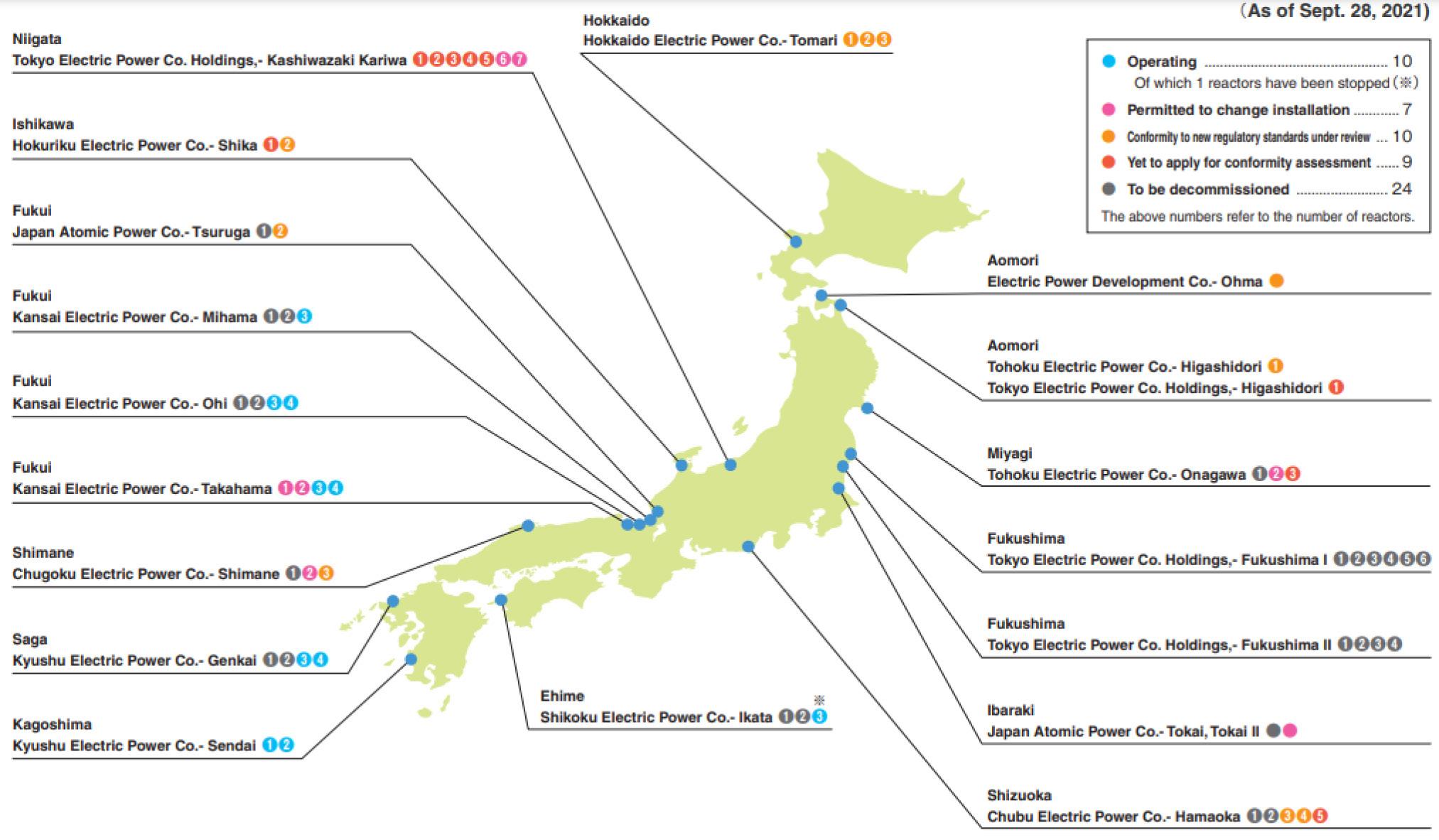
Despite the limited commitment to date on advanced nuclear technology, the nuclear industry is one of the four energy-related industries identified as growth opportunities in the “Green Growth Strategy Through Achieving Carbon Neutrality in 2050 ” released by the Ministry of Economy, Trade and Industry (METI) in late 2020, which is described as an industrial policy supporting the goal of carbon neu trality by 2050.111 This strategy was established to set goals and establish necessary policies to support the growth of fourteen industrial fields that will support Japan’s car
bon-neutrality goal, as well as providing a basis for eco nomic growth. The strategy states that the government will support efforts of Japanese companies to participate in for eign demonstrations of advanced reactors. However, the strategy does not appear to contemplate demonstrations or deployments of commercially focused advanced reactors in Japan, though Prime Minister Kishida's statements indi cate that could change in the future. Limiting this effort to foreign demonstrations will place Japanese companies at a competitive disadvantage in development efforts, and an inability to deploy advanced nuclear technologies domesti cally will make it harder to market them in other countries. Furthermore, an unwillingness to consider demonstrations domestically ignores a potential opportunity to direct public focus to the future of nuclear power that is currently being explored internationally, rather than the politically challeng ing restarts of existing units.
110 “Restart of High Temperature Engineering Test Reactor,” Japan Atomic Energy Agency, July 2021, https://www.jaea.go.jp/english/news/press/2021/073003/
111 “‘Green Growth Strategy Through Achieving Carbon Neutrality in 2050’ Formulated,” Ministry of Economy, Trade, and Industry of Japan, December 25, 2020, https://www.meti.go.jp/english/press/2020/1225_001.html
Conclusion
In the context of the energy crisis triggered by the war in Ukraine, as well as the ongoing commitment to addressing climate change, many countries have made an enhanced commitment to reducing their dependence on fossil fuels. The challenges to achieve these reductions will be signif icant, and will be different for each country. For example, to achieve the IEA’s net-zero targets, renewable genera tion would need to grow by 940 GW per year on average between 2030 and 2050, four times the record pace achieved in 2020.112 Transmission capacity and energy stor age, including new forms of energy storage not yet deployed, will also need to be added in vast quantities.
Nuclear energy can contribute to energy security and decar bonization efforts and increase the likelihood that an energy transition can be achieved in the time required, through pro viding zero-carbon power that is not dependent on local renewable resources, does not require storage to produce consistent power, and requires less land than renewable generation. The IPCC itself, the International Energy Agency, and many governments have concluded that nuclear energy can be a key component of these transition efforts.113 The instability driven by the war in Ukraine has led to increasing recognition that nuclear energy can be a key tool to address both climate concerns and energy security.
The United States benefits from substantial renewable resources, but nuclear power could serve a significant role, especially in key regions, as a dispatchable power resource and as a source of industrial energy and hydrogen or alter native fuels. Japan has much more limited options to pursue decarbonization, and appears poised to pursue a difficult and expensive course of continuing its reliance on imported fuels (fossil and, later, hydrogen) and even the ability to export carbon dioxide for sequestration elsewhere. Should Japan be able to rebuild public trust in the technology, nuclear
energy is technically well suited to its energy challenges and could provide power and hydrogen while accommodat ing the country’s geographic and electric-transmission con straints. Rebuilding trust is feasible, as evidenced by the sup port for nuclear energy in many parts of Europe and from the members of the European Parliament, and the recognition by many governments and advocates that it will need to be part of a net-zero future.114
Policy Recommendations
There are a range of policy options that could enable the United States and Japan to strengthen their ability to achieve decarbonization objectives while improving energy security, reliability, and resilience. In particular, policymakers should consider the following actions.
• Encourage and support international cooperation in advanced nuclear development and deployment. The United States is supporting the future of nuclear power with financial assistance through the ARDP, the Inflation Reduction Act, and other programs, as well as past and pending legislative efforts. These efforts could be enhanced through international partnerships that could involve investments and/or supply commitments, such as IHI Corporation’s and JHG Holdings’ investments in NuScale, Mitsubishi’s and JAEA’s agreements to cooper ate with TerraPower on the development of sodium-cooled fast reactors, or joint research and development, such as participation in the Versatile Test Reactor (VTR).115 Japan’s Green Growth Strategy describes a roadmap on SMRs that includes Japanese participation in foreign demonstration projects.116 Cooperation in international projects could be essential to compete with Russia and China, including strengthening cooperation on financing nuclear projects.
112 “Net Zero by 2050.”
113 “Global Warming of 1.5°C,” Intergovernmental Panel on Climate Change,” https://www.ipcc.ch/sr15/ and https://www.iea.org/reports/net-zero-by-2050
114 Bordoff, “3 Reasons Nuclear Power Has Returned to the Energy Debate.”
115 “IHI Corporation Enters Small Modular Reactor Market Through Investment in NuScale Power,” IHI, press release, May 27, 2021, https://www.ihi.co.jp/en/all_news/2021/ resources_energy_environment/1197417_3360.html; “JGC Holdings Enters EPC Business for Small Modular Reactors (SMRs) Invests in U.S. Company NuScale Power,” JGC Holdings, press release, April 6, 2021, https://www.jgc.com/en/news/2021/20210406.html; “US, Japanese Firms Agree to Cooperate on Fast Reactors,” World Nuclear News, January 27, 2022, https://www.world-nuclear-news.org/Articles/US,-Japanese-firms-agree-to-cooperate-on-fast-reac
116 “‘Green Growth Strategy Through Achieving Carbon Neutrality in 2050’ Formulated.”
Secretary of Energy Jennifer Granholm has commented that partnerships between nations and industries may be key for US nuclear developers and operators to participate in the global clean-energy market.117 One action that could enhance cooperation would be to remove anachronistic restrictions on foreign ownership in nuclear power plants.118
• Accelerate the development of a reliable supply chain. While the ARDP and other programs help support initial deployments of advanced technologies, a key to a suc cessful advanced-reactor industry will be efficient man ufacturing and a reliable supply chain. The weakened nuclear manufacturing base has also been cited as a fac tor in the challenges to recent conventional nuclear proj ects.119 International cooperation, such as participation by Japan’s strong manufacturing sector, perhaps in the form of advance commitments to creating manufacturing capa bilities, could help to address this need.
• Work toward regulatory harmonization: Similarly, inter national cooperation could help achieve harmonized, and more efficient, licensing processes. The reintroduced American Nuclear Infrastructure Act would authorize the Nuclear Regulatory Commission (NRC) to support interna tional regulatory cooperation.120 Licensing improvements that will help shorten licensing timelines and reduce the need to repeat licensing steps for international deploy ment will be essential to growing the international mar ket, and enabling advanced reactors to contribute to decarbonization.
• Consider a path toward advanced nuclear demonstration in Japan. Japan is seeking to rebuild public trust in nuclear power, which will be an essential component of its decar bonization efforts. Currently, that effort is almost entirely
focused on restarting existing reactors. The Green Growth Strategy contemplates Japanese progress in advanced nuclear energy principally through research and partici pation in demonstrations outside Japan. A demonstration project within Japan, whether focused on electric supply or, perhaps, hydrogen production, would be consistent with Prime Minister Kishida's renewed emphasis on nuclear power, and could offer a different, and perhaps more for ward-looking, framework for rebuilding trust. To the extent Japan could make progress on advanced nuclear power and hydrogen production from nuclear energy domesti cally, perhaps even using nuclear desalination, it would not only support its own self-sufficiency goals, but also develop a product for export to other countries with limited renewable-resource options. Of course, the government also needs to maintain consistent progress toward restart ing the remaining reactors that have not been decommis sioned, and to support an efficient path toward achieving the lifetime extensions that will be necessary to meet the objectives in the Strategic Energy Plan, while maintaining the focus on safety that is a central principle of the plan.
The challenges to reduce dependence on fossil fuels, improve energy security, and meet climate commitments will be significant. Nuclear power can help achieve those objec tives through its ability to generate power, and potentially supply industrial energy and zero-carbon fuels, without car bon emissions, in a compact land area, regardless of geog raphy or renewable resource conditions. Both the US and Japanese governments support the preservation of exist ing nuclear power and demonstration of advanced nuclear generation. Additional efforts could improve the prospects for successfully addressing the sources of climate change in time to mitigate climate impacts, and reducing future threats to energy security.
117 Jonathan Tirone, “Top U.S. Energy Official Sees ‘Unusual Partnerships’ for Nuclear,” Bloomberg, September 21, 2021, https://www.bloomberg.com/news/articles/2021-09-21/top-u-s-energy-official-sees-unusual-partnerships-for-nuclear
118 Matt Bowen, Jennifer T. Gordon, and Jackie Siebens, “Strengthening Cooperation with Allies Could Help the United States Lead in Exporting Carbon-Free Nuclear Energy,” EnergySource, October 7, 2020, https://www.atlanticcouncil.org/blogs/energysource/strengthening-cooperation-with-allies-could-help-the-united-states-lead-in-exporting-carbon-free-nuclear-energy/
119 “Reducing the Costs of Nuclear Power on the Path Towards a Clean Energy Future,” Nuclear Energy Agency, July 2, 2020, https://www.oecd-nea.org/jcms/pl_37787/reducing-the-costs-of-nuclear-power-on-the-path-towards-a-clean-energy-future.
120 Roma and Fishman, “American Nuclear Infrastructure Act Makes a 2021 Comeback.”
About the Author
Stephen S. Greene is a former energy and finance executive with extensive expe rience in commercial and policy issues related to energy. Most recently, he served in senior finance roles, including as chief financial officer for Centrus Energy, a pub lic company engaged in the sale of nuclear fuel and the development of nuclear enrichment technology. He led strategy for Progress Energy, an investor-owned elec tric utility, and served as practice-area leader for the con sultant Pace Global Energy focused on energy markets and risk management. He arranged project financing for PG&E National Energy Group (US Generating Company), a lead ing independent-power developer and energy trader, and subsequently developed the company’s power market out look to support project development. Early in his career, he worked at the US Environmental Protection Agency on air-pollution rules. He holds a masters in public policy from the Harvard Kennedy School and a BA in physics from Princeton University.

CHAIRMAN
*John F.W. Rogers
EXECUTIVE CHAIRMAN
EMERITUS
*James L. Jones
PRESIDENT AND CEO
*Frederick Kempe
EXECUTIVE VICE CHAIRS
*Adrienne Arsht
*Stephen J. Hadley
VICE CHAIRS
*Robert J. Abernethy
*C. Boyden Gray
*Alexander V. Mirtchev
TREASURER

*George Lund
DIRECTORS
Todd Achilles
Timothy D. Adams
*Michael Andersson
David D. Aufhauser
Barbara Barrett
Colleen Bell
Stephen Biegun
Linden P. Blue
Adam Boehler
John Bonsell
Philip M. Breedlove
Myron Brilliant
*Esther Brimmer
Richard R. Burt
*Teresa Carlson
*James E. Cartwright
John E. Chapoton
Ahmed Charai
Melanie Chen
Michael Chertoff
*George Chopivsky
Wesley K. Clark
*Helima Croft
*Ankit N. Desai
Dario Deste
*Paula J. Dobriansky
Joseph F. Dunford, Jr.
Richard Edelman
Thomas J. Egan, Jr.
Stuart E. Eizenstat
Mark T. Esper
*Michael Fisch
Alan H. Fleischmann
Jendayi E. Frazer
Meg Gentle
Thomas H. Glocer
John B. Goodman
*Sherri W. Goodman
Jarosław Grzesiak
Murathan Günal
Frank Haun
Michael V. Hayden
Tim Holt
*Karl V. Hopkins
Kay Bailey Hutchison
Ian Ihnatowycz
Mark Isakowitz
Wolfgang F. Ischinger
Deborah Lee James
*Joia M. Johnson
*Safi Kalo
Andre Kelleners
Brian L. Kelly
Henry A. Kissinger
John E. Klein
*C. Jeffrey Knittel
Joseph Konzelmann
Franklin D. Kramer
Laura Lane
Almar Latour
Yann Le Pallec
Jan M. Lodal
Douglas Lute
Jane Holl Lute
William J. Lynn
Mark Machin
Umer Mansha
Marco Margheri
Michael Margolis
Chris Marlin
William Marron
Christian Marrone
Gerardo Mato
Erin McGrain
John M. McHugh
*Judith A. Miller
Dariusz Mioduski
Michael J. Morell
*Richard Morningstar
Georgette Mosbacher
Majida Mourad
Virginia A. Mulberger
Mary Claire Murphy
Edward J. Newberry
Franco Nuschese
Joseph S. Nye
Ahmet M. Ören
Sally A. Painter
Ana I. Palacio
*Kostas Pantazopoulos
Alan Pellegrini
David H. Petraeus
*Lisa Pollina
Daniel B. Poneman
*Dina H. Powell dddMcCormick
Michael Punke
Ashraf Qazi
Thomas J. Ridge Gary Rieschel
Lawrence Di Rita Michael J. Rogers
Charles O. Rossotti
Harry Sachinis C. Michael Scaparrotti
Ivan A. Schlager
Rajiv Shah
Gregg Sherrill Jeff Shockey Ali Jehangir Siddiqui Kris Singh
Walter Slocombe
Christopher Smith
Clifford M. Sobel
James G. Stavridis
Michael S. Steele
Richard J.A. Steele Mary Streett
*Gil Tenzer
*Frances M. Townsend Clyde C. Tuggle
Melanne Verveer
Charles F. Wald
Michael F. Walsh
Ronald Weiser
*Al Williams Maciej Witucki Neal S. Wolin
*Jenny Wood Guang Yang Mary C. Yates Dov S. Zakheim
HONORARY DIRECTORS
James A. Baker, III
Ashton B. Carter
Robert M. Gates
James N. Mattis
Michael G. Mullen
Leon E. Panetta
William J. Perry
Condoleezza Rice
Horst Teltschik
William H. Webster
*Executive Committee Members
List as of October 20, 2022

The Atlantic Council is a nonpartisan organization that promotes constructive US leadership and engagement in international affairs based on the central role of the Atlantic community in meeting today’s global challenges.
1030 15th Street, NW, 12th Floor, Washington, DC 20005 (202) 778-4952
www.AtlanticCouncil.org

